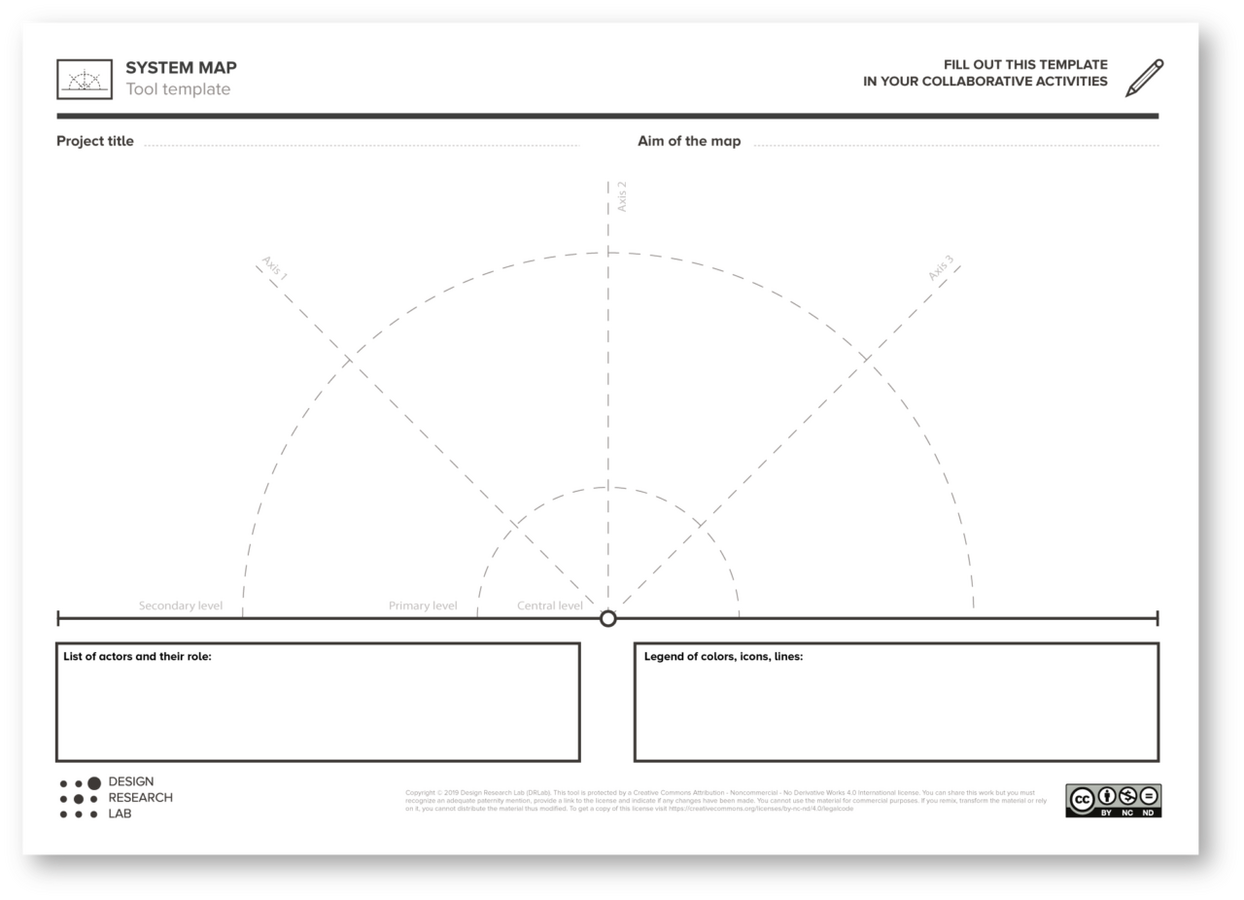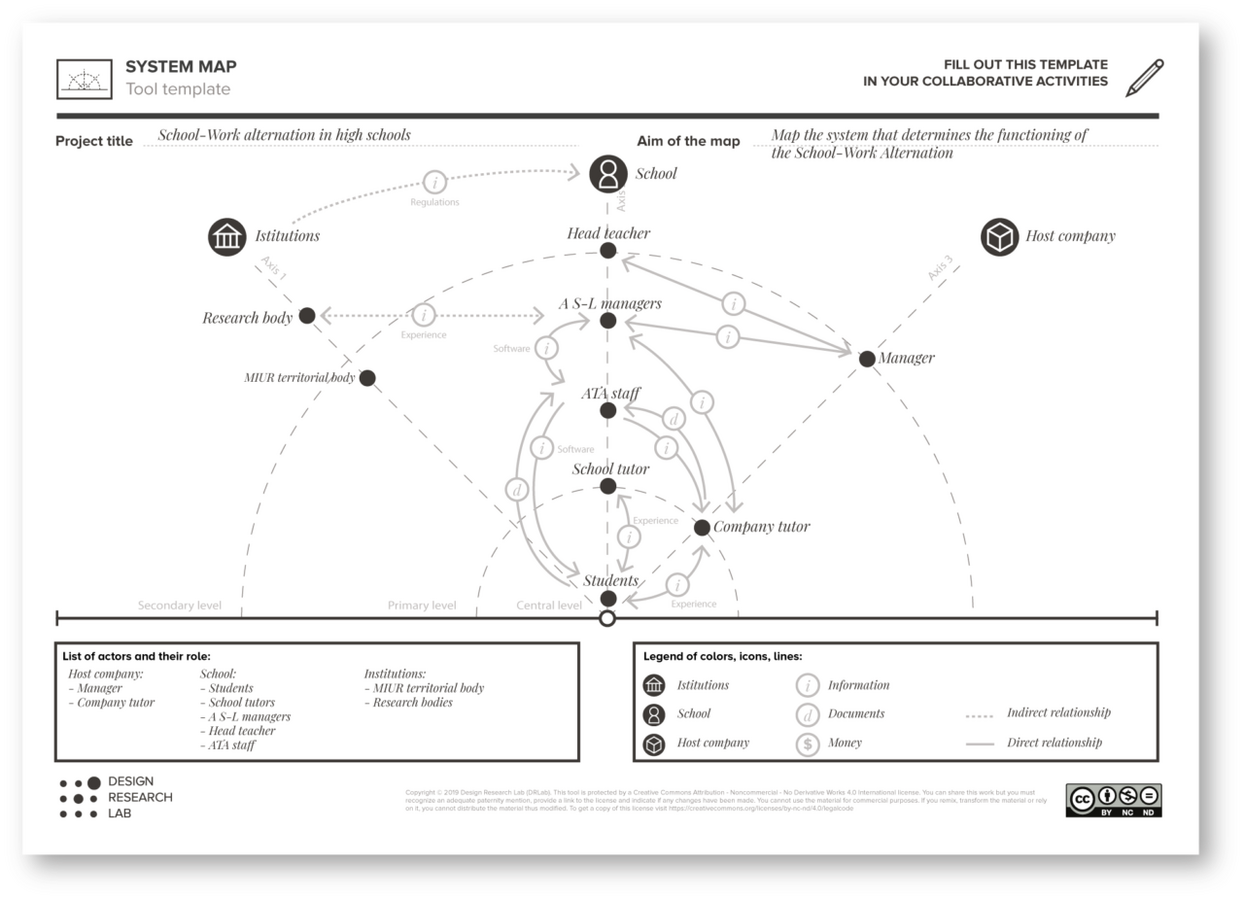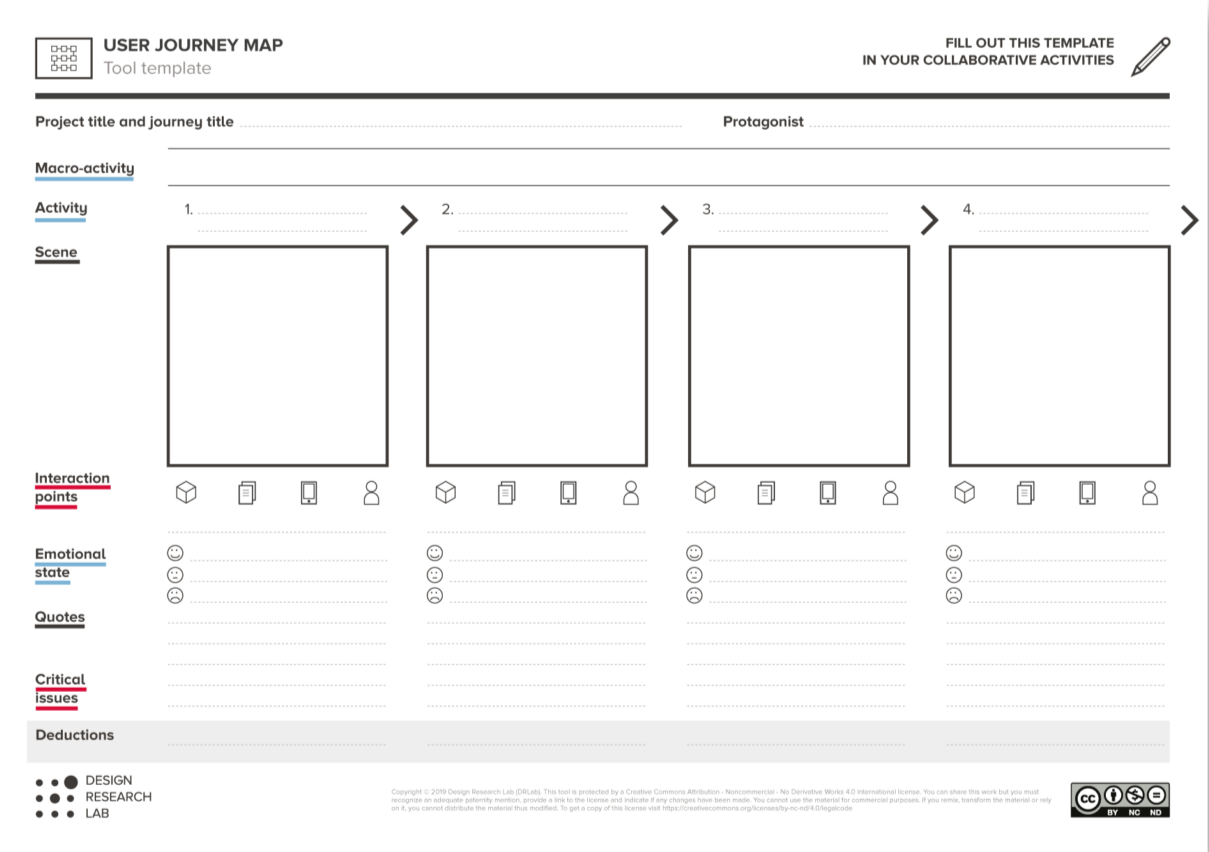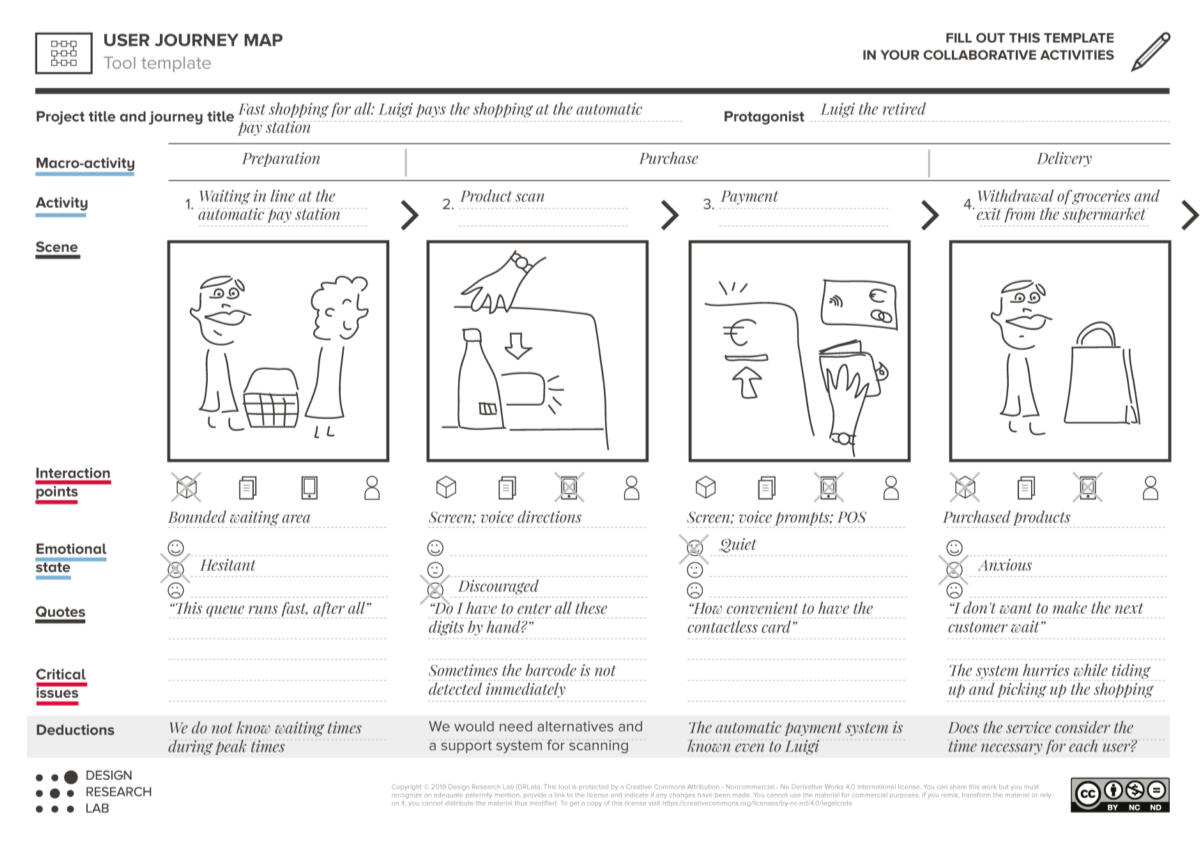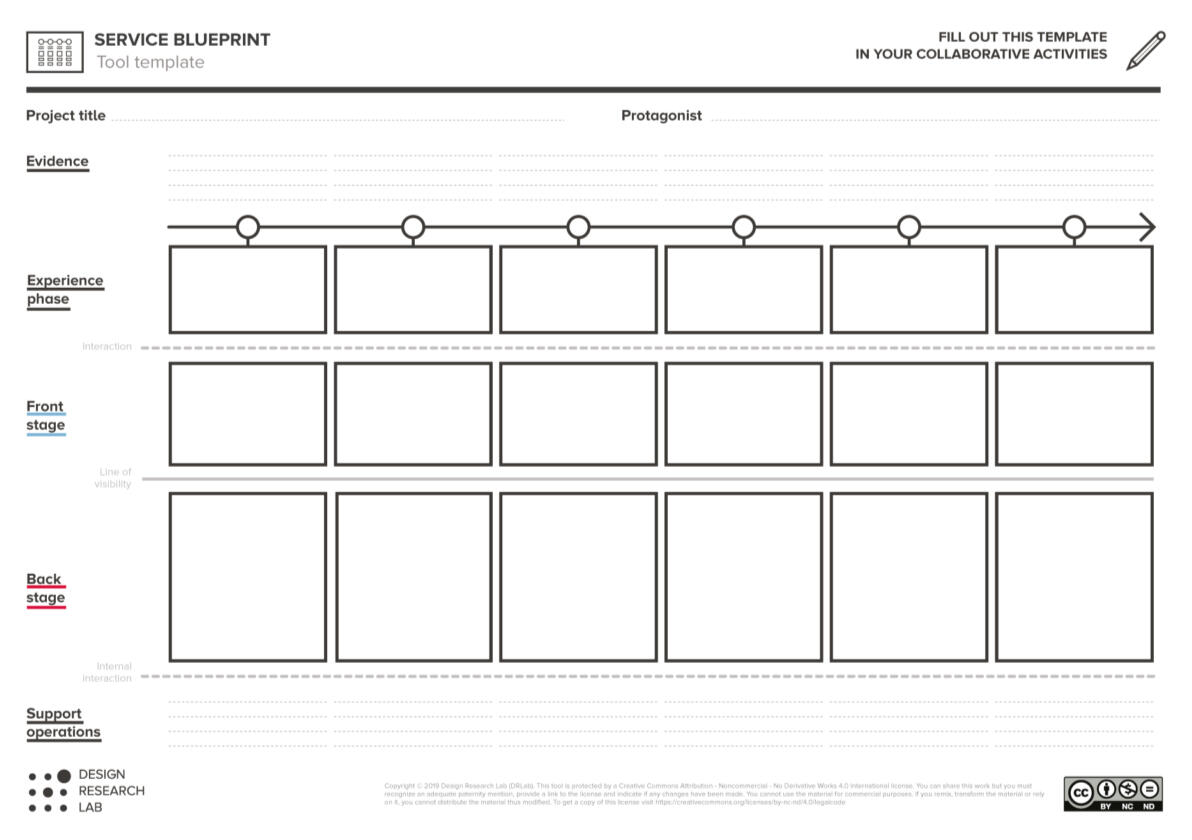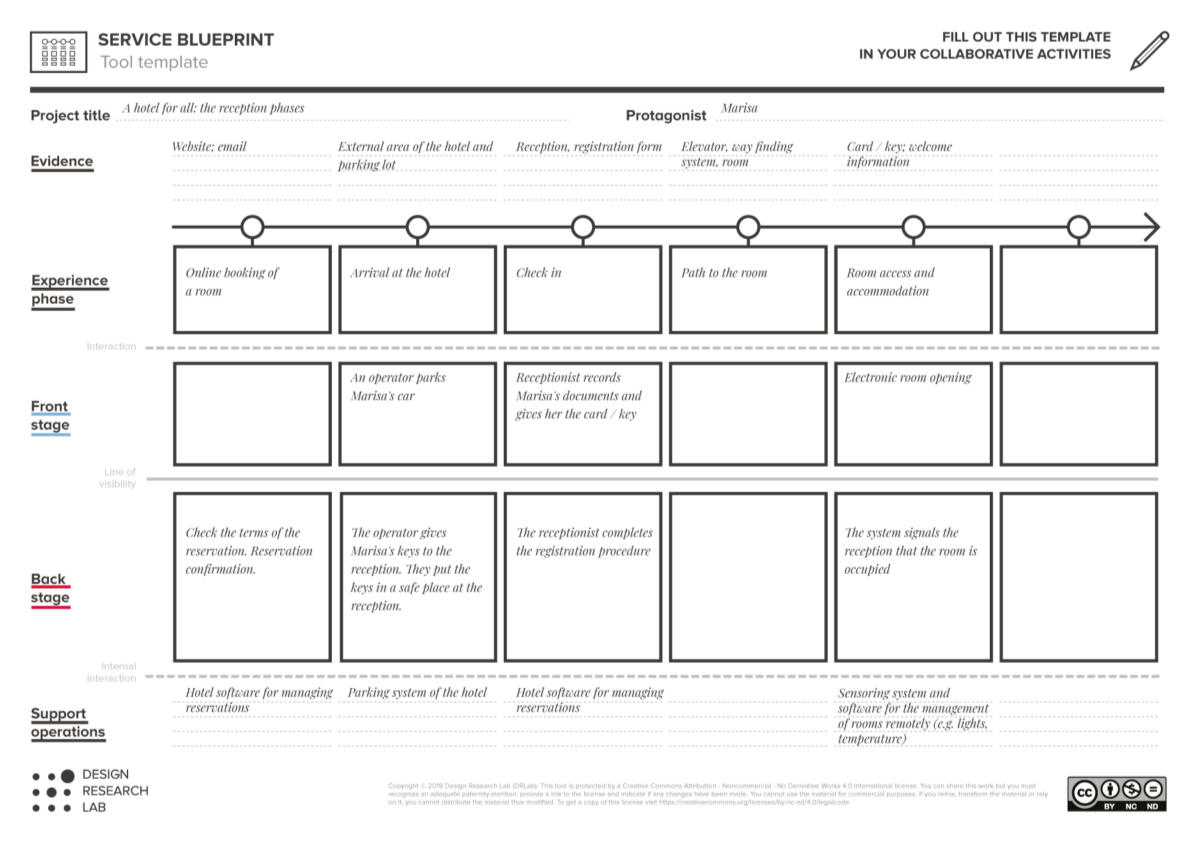Service Design Today
A knowledge Vault for Makers
We're a tight-knit group of passionate individuals who love all things related to Service Design.

Design Ability Project
You will find:
1.Tools
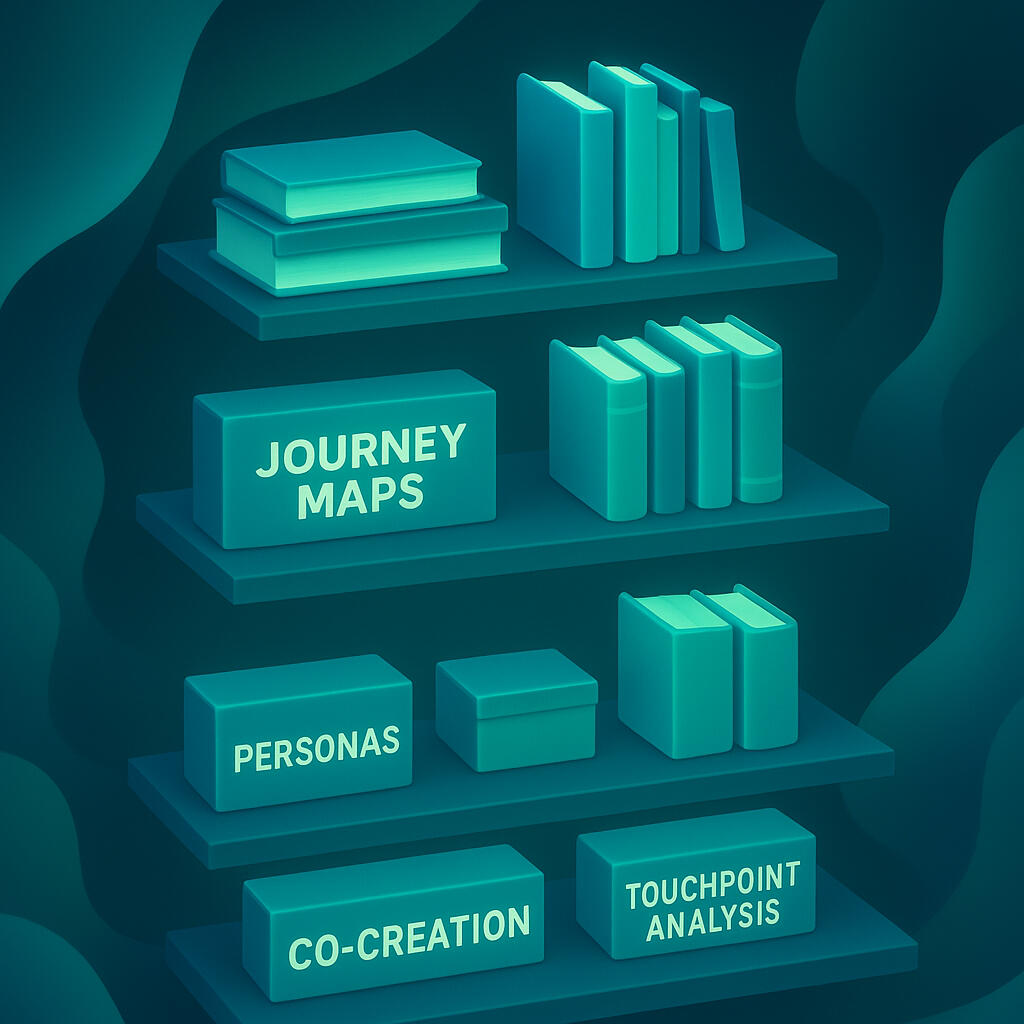
Discover an open access library of service design tools, based on research.
2.Guidelines

Discover expertly curated guidelines, website links and books to elevate your knowledge.
3.Articles

Free and open-source library of articles, topics and trends practical on service design from around the web.
Most wanted
4.Case Studies
Projects conducted by brilliant researchers and active practitioners, where ideas are diffused from academia to practice.
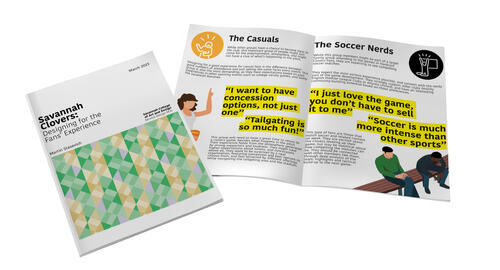
Savannah Clovers Fans Experience
How Service Design tools and contextual research methodology can impact the offerings of a Soccer Club to their fans by uncovering how their ideal experience might look and feel.

C.LAB Project
How Service Design can help in changing the comprehension and create new areas of development in a problematic neighborhood in Milan? A project where social impact, football passion and Service Design meet.
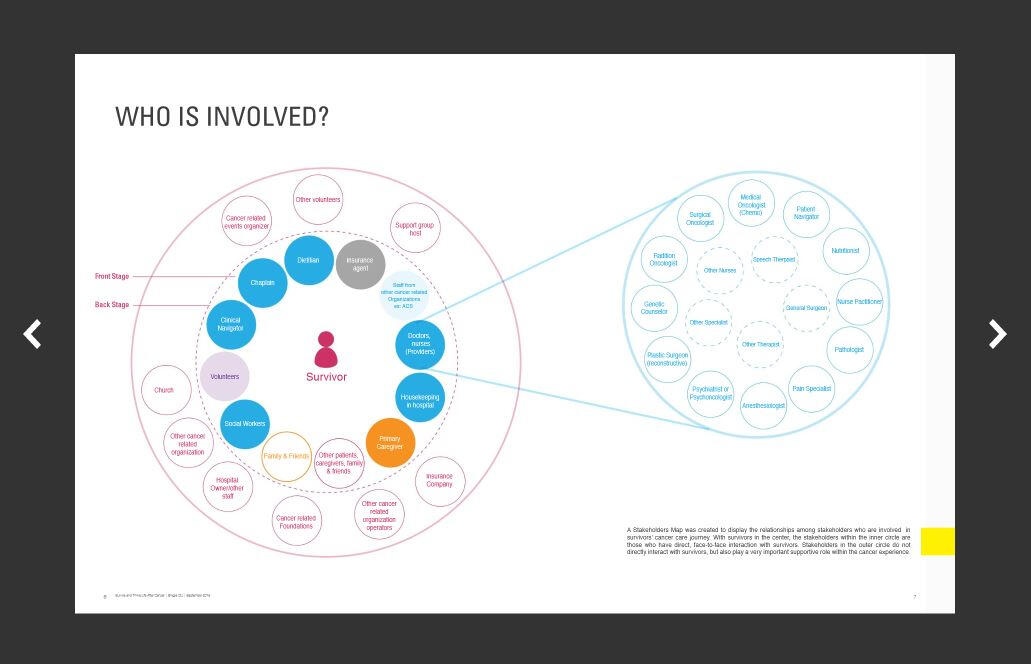
Survive and Thrive- Life After Cancer
A book that enables Service Designers and Healthcare Providers to innovate in cancer care.
Tools
Discover an open access library of service design tools, based on cutting-edge research. Explore materials resulting from laboratory's findings.
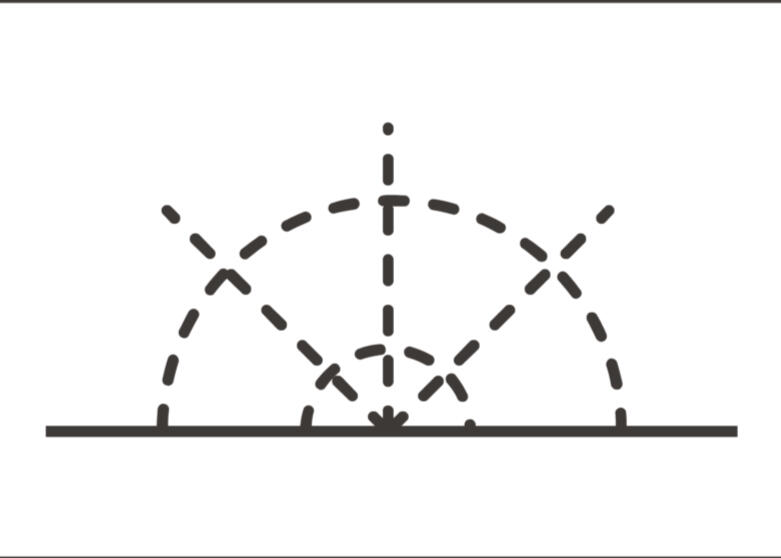
Available
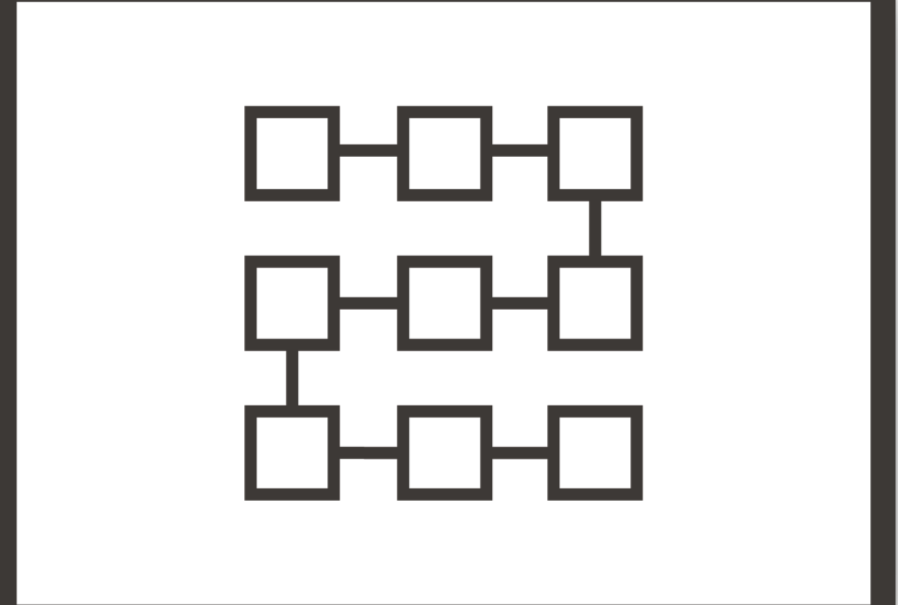
Available
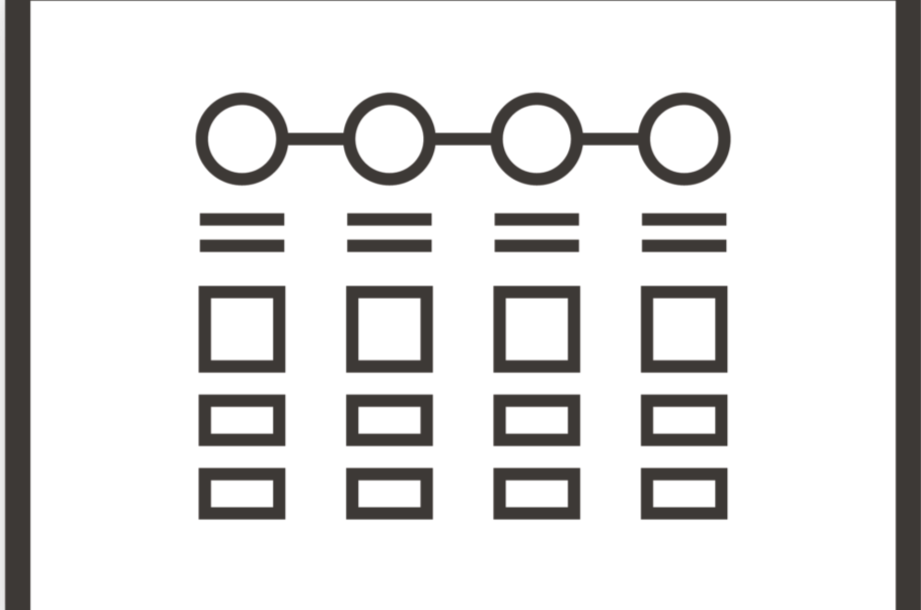
Available

Available
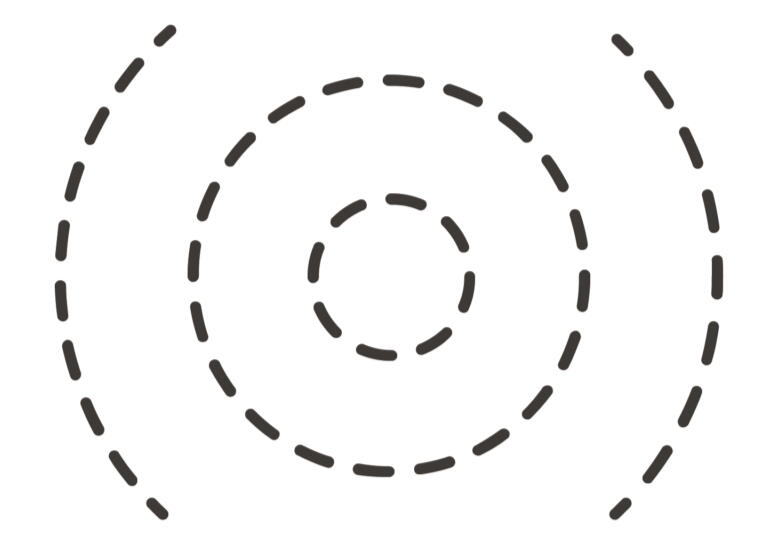
Available

Available
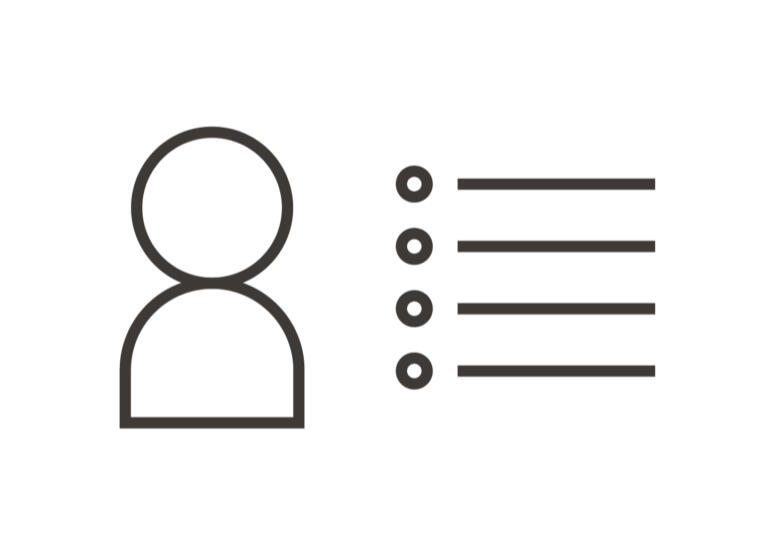
Available

Coming Soon
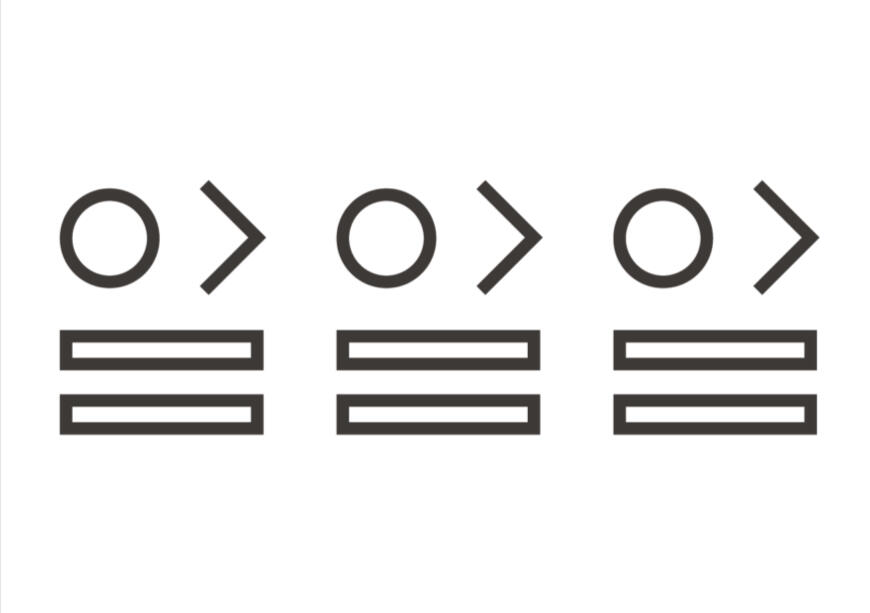
Coming Soon
System map
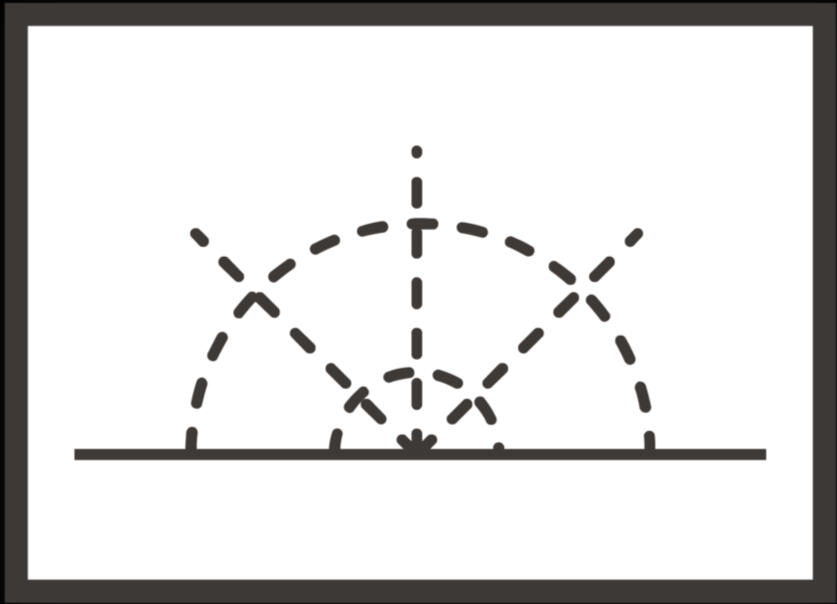
A system map is a concise representation that shows all the different actors involved in a service/system in one framework, along with all the relations that connect them to each other (e.g. material flows, energy, information economic resources, documents). The map highlights the elements and roles within a service/system as well as the connections between them, emphasizing the value of their interaction.
To download this image: (right) click on the image and select "save image as"
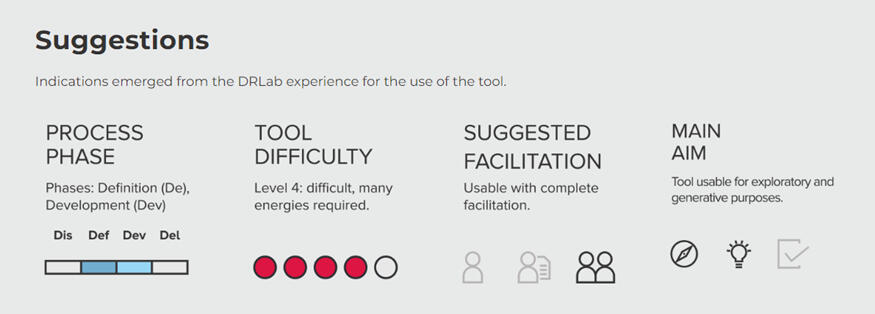
Instructions for using the template
Premise. An effective system map is based on research data. Before proceeding with the compilation of the map, this data needs to be made easily available to the working group.1. Indicate the project title. Indicate the mapping goal.2. List the actors who might potentially be part of the system that needs to be visualized.Make a list of the primary and secondary actors: the user, the principal actors that provide the service, the partners, the secondary providers and all the institutional bodies and groups involved in a direct way. Each of them should be represented by an icon that also indicates its role and the main activity they perform within the system.3. Define a legend with the actors’ icons, colours, and icons and/or symbols that represent the connections and relations.4. Define the actors’ position on the map according to the priorities and levels of interest from the centre. The furthest from the centre still has a role in the system, but occupies a secondary level.5. Identify the flows and relations that run between the actors, divided up on the basis of first and second levels. Represent them according to typology: e.g. economic flows, material flows, information flows. This allows the relations and connection with the whole system to be visualized. Identify the starting point for a sequence of flows; number them and describe them in a synthetic manner.
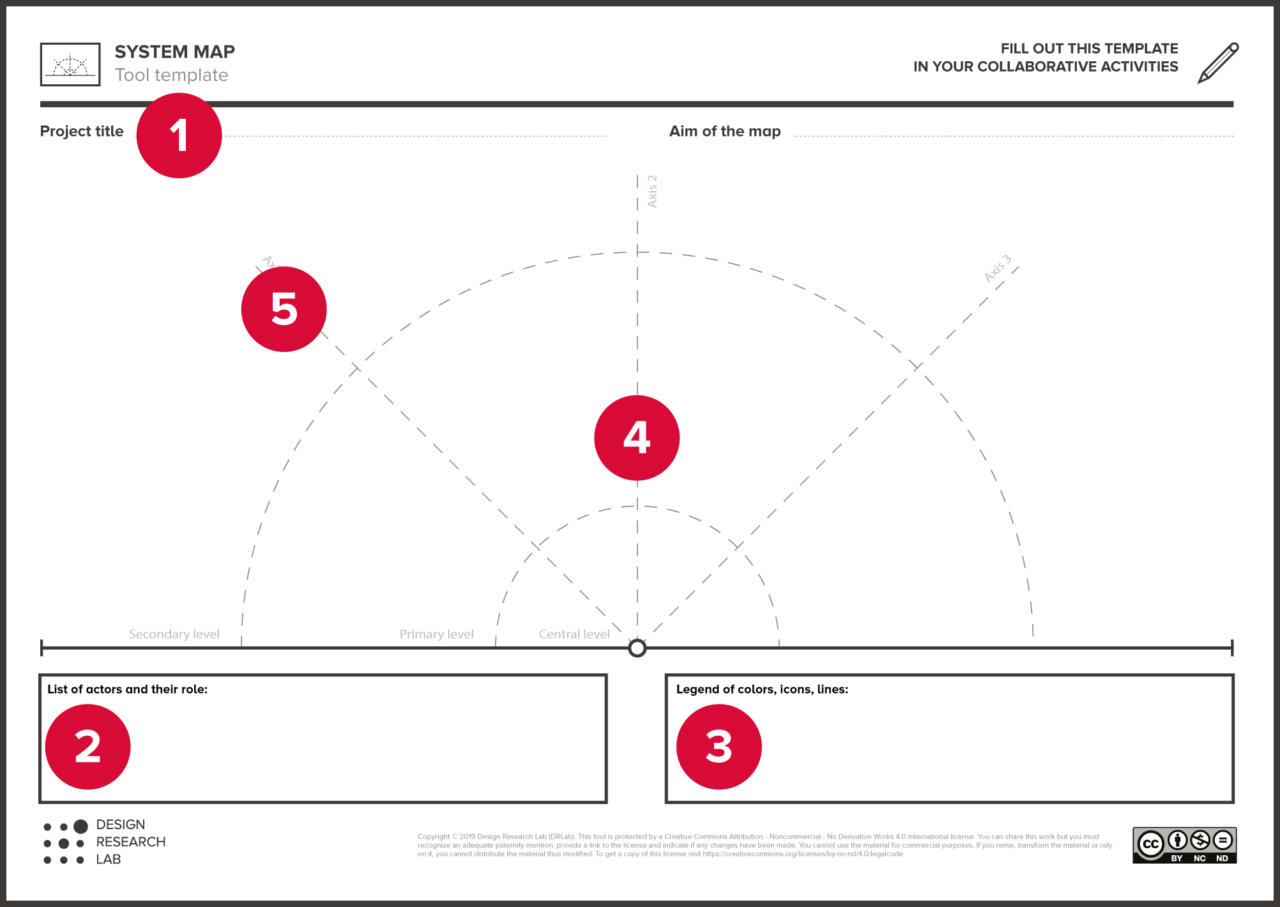
To download this image: (right) click on the image and select "save image as"
N.B. Grouping the actors together facilitates an understanding of the actors’ organization within their system. Using post-its to manage the position of groups, sub-groups and single actors helps the discussion and for the map construction to be an interactive process.
References
Meroni, A., & Sangiorgi, D. (2011). Design for services. Gower Publishing, Ltd.Segelström, F., & Holmlid, S. (2011). Service design visualisations meet service theory: strengths, weaknesses and perspectives. Proceedings of Art & Science of Service, San Jose, California.Stickdorn, M., Lawrence, A., Hormess, M., & Schneider, J. (2018). This is service design doing: Applying service design thinking in the real world. O’Reilly Media, Inc.
User Journey Map
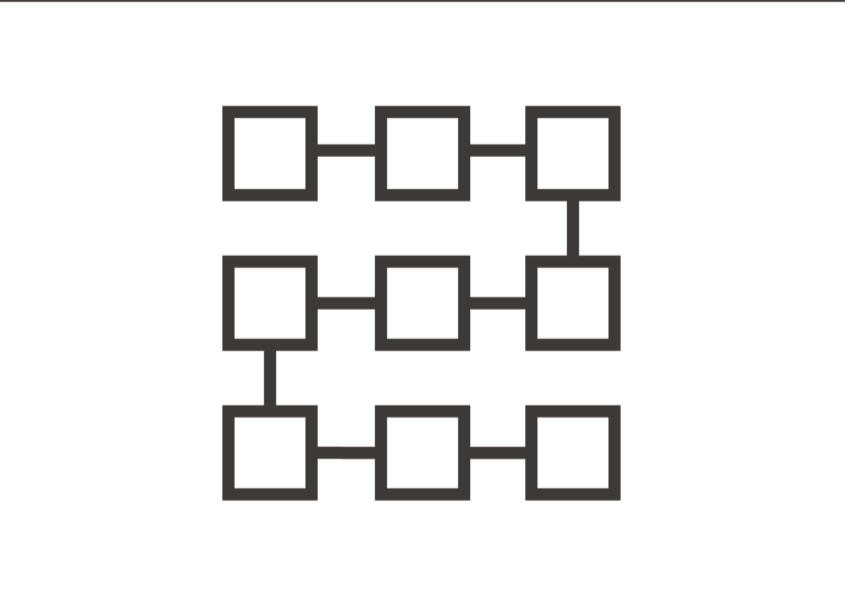
Graphical representation of a flow that describes the experience of a user when interacting with a service. The map allows us to visualize the sequence of activities in terms of relevant features, problems and opportunities that contribute to defining the service’s level of performance.
To download this image: (right) click on the image and select "save image as"
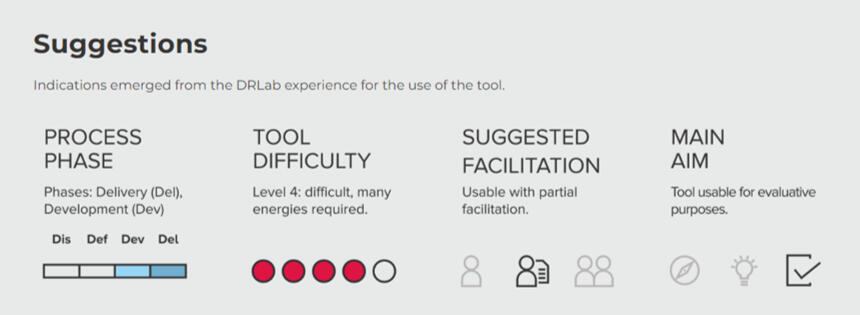
Instructions for using the template
Premise. An effective user journey map relies on research data. Before proceeding with compiling the map, make the data easily available to the working group.1. Identify the project title and the title of the journey to be described through the experience of the protagonist’s interactions with the service. Indicate the protagonist of the experience in order to describe his/her specific interaction with the service.2. Relate the activities that describe the protagonist’s experience.3. RGroup together the activities previously identified into macro-activities that describe the protagonist’s experience.4. For each activity, represent the scene by using visualization and description, e.g. words, drawings, sketches, images, illustrations, photographs.5. Indicate the interaction points touchpoints of the reference scene, or the elements through or through which the protagonist has an interaction with the service. The points of interaction can be manifested to the protagonist in the form of objects, documents, digital products, people, or other items to be crossed and indicated in the appropriate spaces.6. Indicate the emotional state of the protagonist in relation to the individual activities of the service using words connected to the icons.7. Report a quote of the protagonist that describes his/her point of view of the scene.8. Indicate critical issues that arise in each phase of the experience, relating to the protagonist and their interactions with the service.9. For each activity, report what can be deduced from the analysis of the previous points (macro-activities, activities, scene, points of interaction, emotional state, issues, citations).
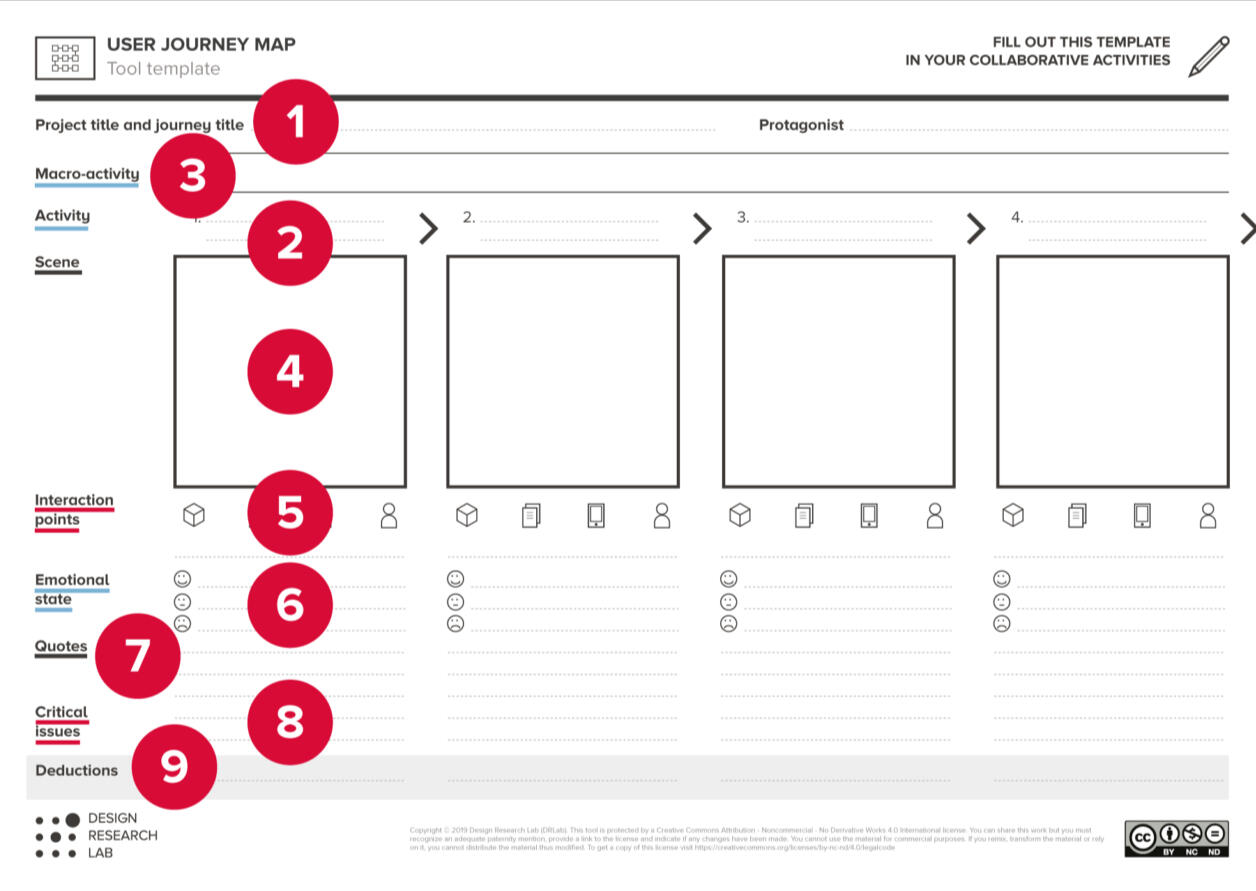
To download this image: (right) click on the image and select "save image as"
N.B. The protagonist can be traced back among the profile personas, or can express the features of a hypothetical user if more detailed data is not available.N.B. The greater the awareness of the project context through explorational activities and previous research – such as design ethnography – the greater is the ability to complete the map. E.g. activities, moods, quotes are more reliable if they come out of exploring the project’s real context.N.B. The form is in A3 format and can be downloaded from this page; it allows you to describe an experience for up to 4 activities – with scenes represented in a space the size of a post-it. To describe experiences with more than 4 activities, simply print the same form again and use it in continuity, or download the A1 format.
References
Cabinet Office (2016). Open Policy Making toolkit. UK Government. Retrieved from https://www.gov.uk/guidance/open-policy-making-toolkitHanington, B., & Martin, B. (2012). Universal methods of design: 100 ways to research complex problems, develop innovative ideas, and design effective solutions. Rockport Publishers.Meroni, A., & Sangiorgi, D. (2011). Design for services. Gower Publishing, Ltd.Richardson, A. (2010). Using customer journey maps to improve customer experience. Harvard business review, 15(1), 2-5.Stickdorn, M. and Schneider, J. (2011). This is Service Design Thinking: Basics ‐ Tools ‐ Cases. Amsterdam, The Netherlands: BIS Publishers.
Service Blueprint
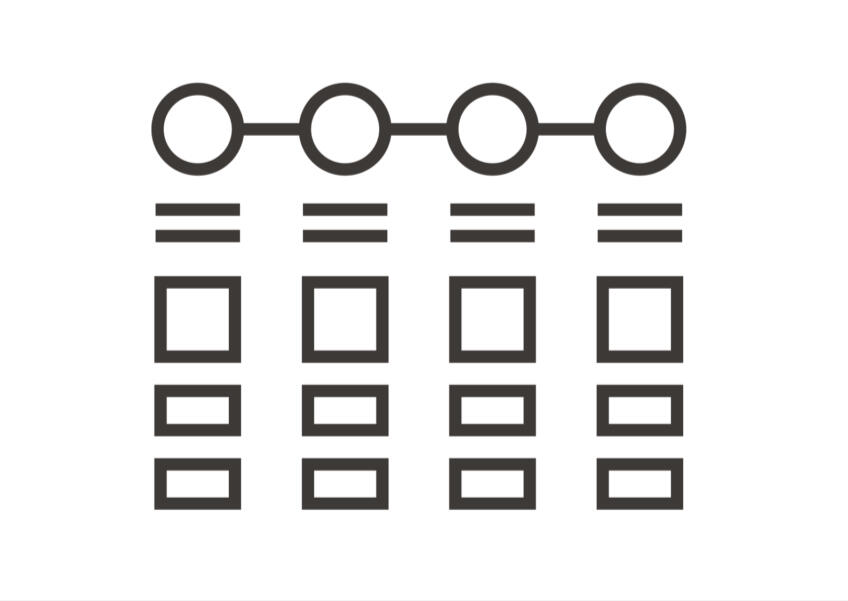
Mapping of the operating flows that make up the entire operation of a service. It is used to visualize service actions, relationships, actors, inputs, outputs, touchpoints. It also puts the evidence between what is visible to the final users of a service and what instead remains invisible but equally crucial for the functioning of the system / service.
To download this image: (right) click on the image and select "save image as"
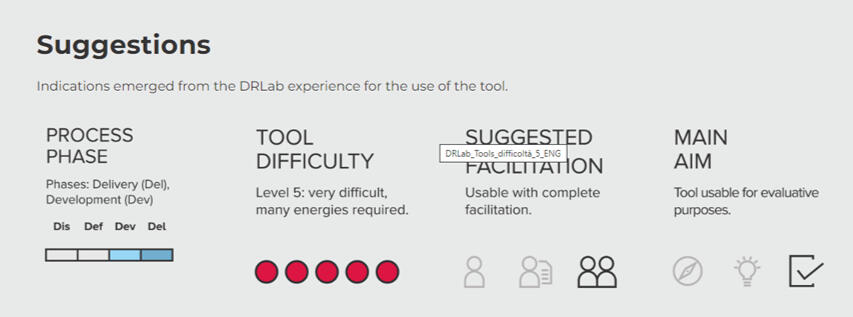
Instructions for using the template
1. Indicate the project title, or the experience that’s going to be described. Indicate the protagonist of all the scene that make up the experience of interacting with the service.2. Indicate the main phases that make up the experience. Each phase or moment describes an interaction activity with an element that makes up the service. It is possible to describe each scene through textual description or with drawings or photographs. Complete all the steps necessary to describe the experience before continuing with the compilation of point 3.3. Use words and/or images to describe the activities of the frontstage, i.e. those processes, activities and actions that are visible to the service user and brought to a conclusion by the service provider (e.g. the waiter that takes an order).4. Use words and/or images to describe the activities of the backstage, i.e. those processes, activities and actions that are not visible to the service user but are brought to a conclusion by the service provider (e.g. the waiter who gives the order to the kitchen).5. Indicate eventual supporting actions, i.e. all those activities that happen within the service system but are carried out by other parts of the organization or by external partners.6. Identify the element that gives evidence and tangibility to the interaction that occurs at each stage of the experience.
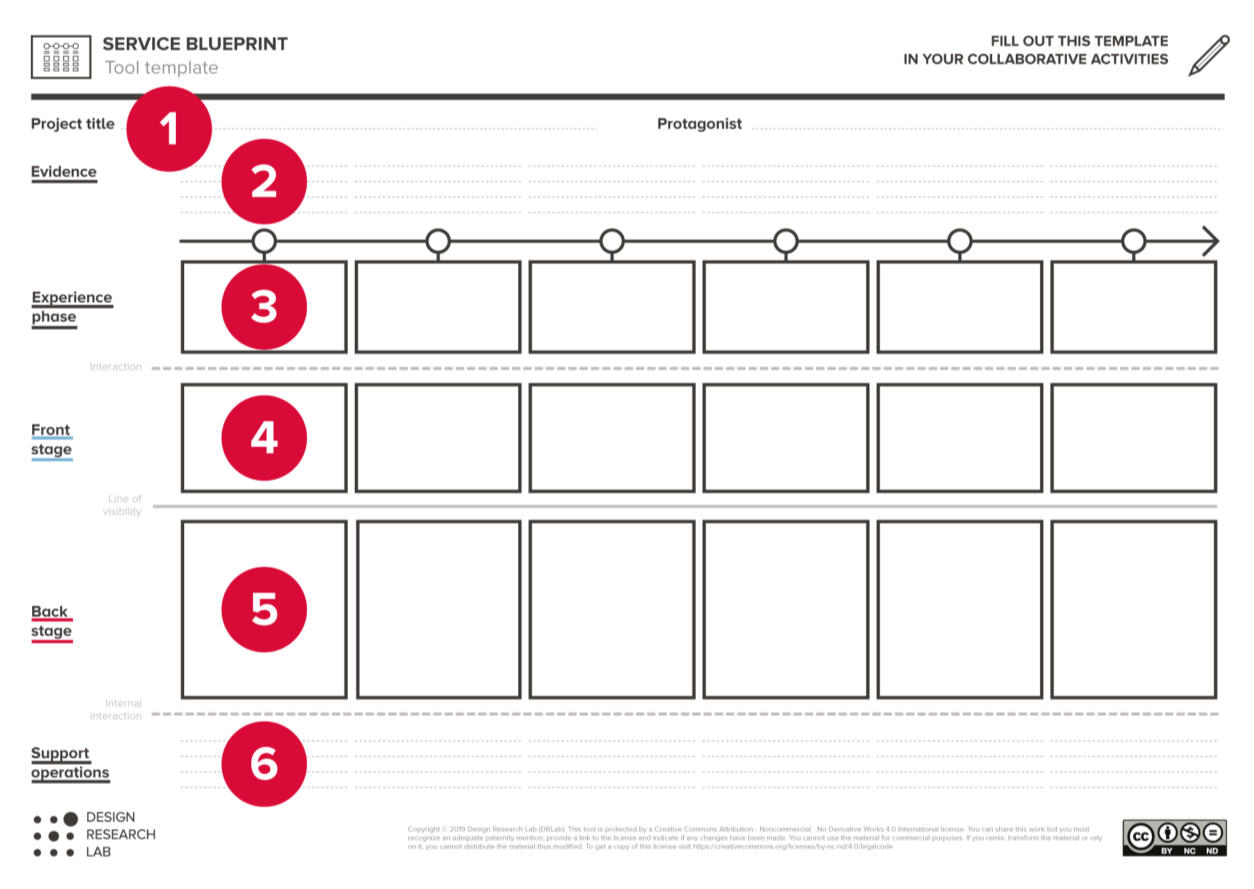
To download this image: (right) click on the image and select "save image as"
N.B. Repeat points 3, 4, 5 and 6 for all of the phases.N.B. The protagonist can be found from among the persona profiles, or can express features of a hypothetical user if more detailed data is not available.
References
Bitner, M. J., Ostrom, A. L., & Morgan, F. N. (2008). Service blueprinting: a practical technique for service innovation. California management review, 50(3), 66-94.Meroni, A., & Sangiorgi, D. (2011). Design for services. Gower Publishing, Ltd.Katzan Jr, H. (2011). Essentials of service design. Journal of Service Science (JSS), 4(2), 43-60.Polaine, A., Løvlie, L., & Reason, B. (2013). Service design: From insight to inspiration. Rosenfeld media.Shostack, G. L. (1982). How to design a service. European journal of Marketing, 16(1), 49-63.Stickdorn, M., Lawrence, A., Hormess, M., & Schneider, J. (2018). This is service design doing: Applying service design thinking in the real world. O’Reilly Media, Inc.
Prototyping plan
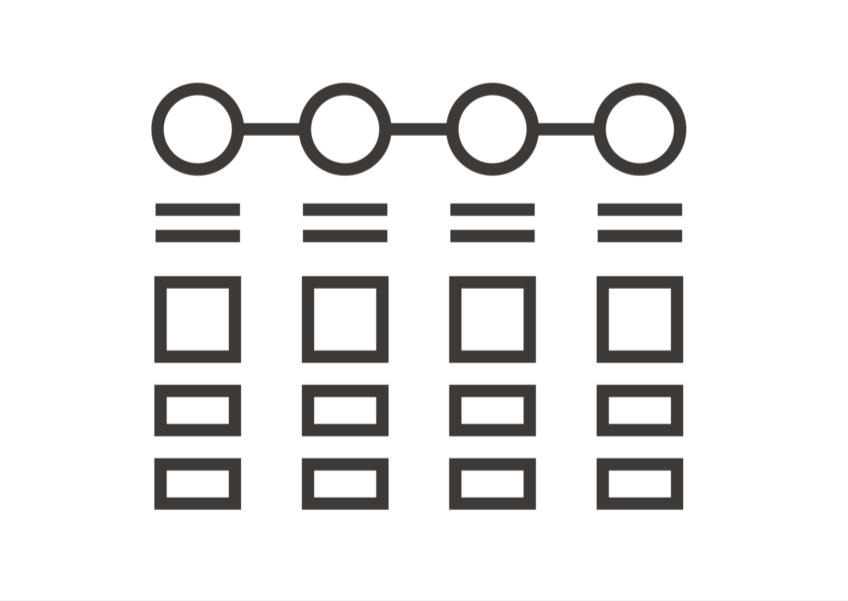
Mapping of the operating flows that make up the entire operation of a service. It is used to visualize service actions, relationships, actors, inputs, outputs, touchpoints. It also puts the evidence between what is visible to the final users of a service and what instead remains invisible but equally crucial for the functioning of the system / service.
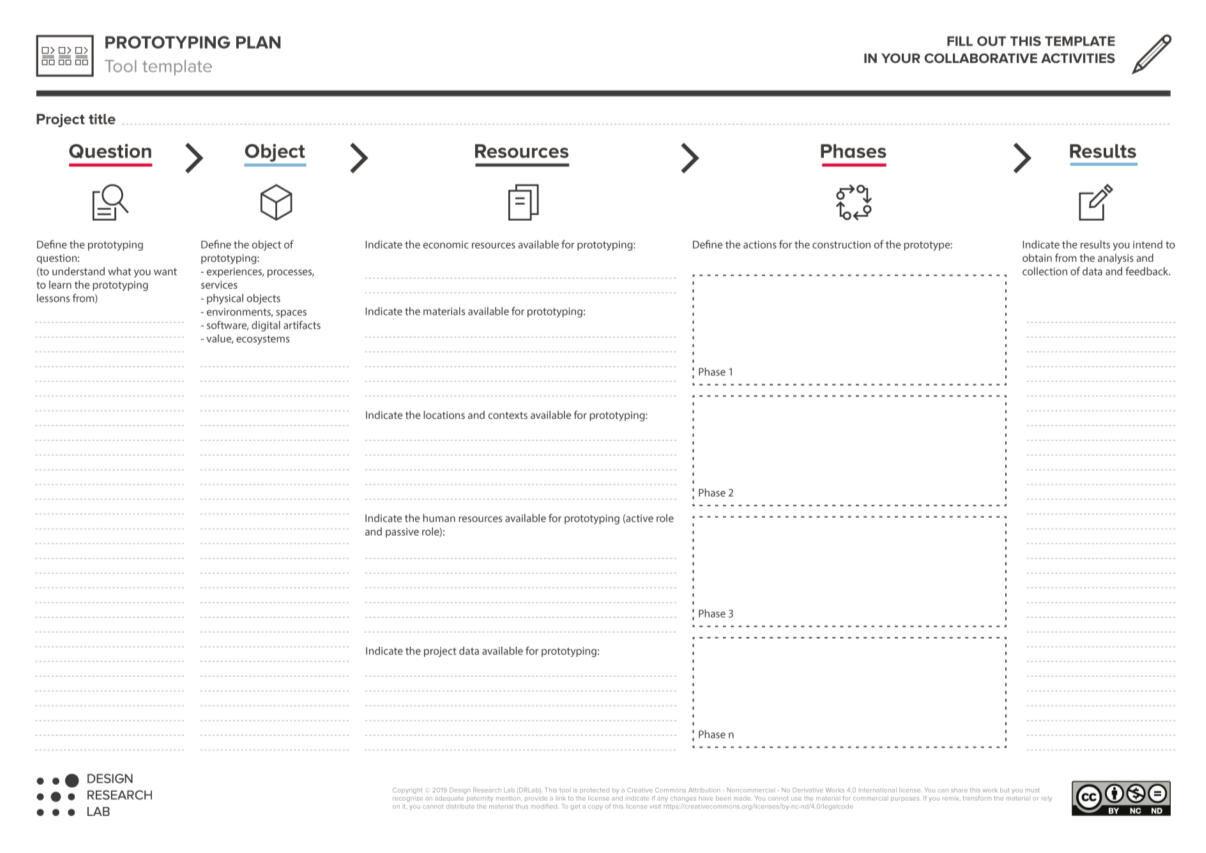
To download this image: (right) click on the image and select "save image as"
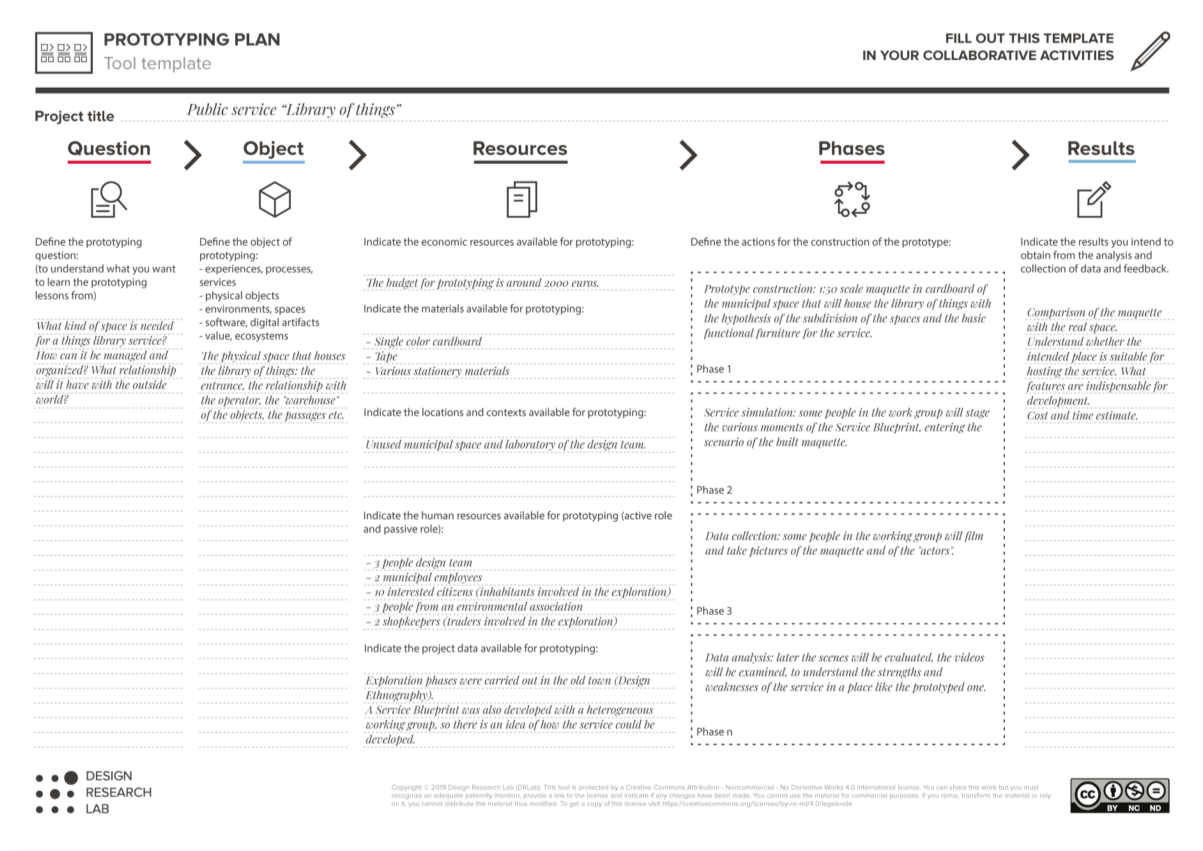
To download this image: (right) click on the image and select "save image as"
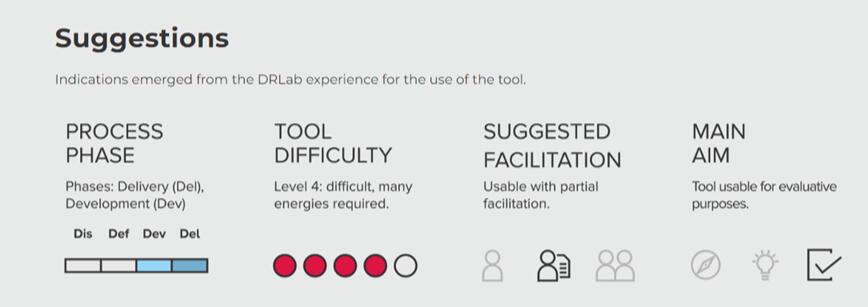
Instructions for using the template
1. Indicate the project title.2. Define the question that guides the prototyping.3. Define the object for prototyping, which might mean a whole service or just a part. This can be an experience or a process, of physical objects or products, contexts or spaces,software or digital products, or even systems.4. Indicate the resources available for prototyping. These include: economic resources, materials, places, people and data known to the project at the centre of the prototyping.5. Structuring the actions of each prototype construction phase. At this point keep in mind:- the choice of context, actors, techniques
- how to use the chosen materials and at what level of fidelity and detail to develop the prototype
- which tools to use for data collection (e.g. photographs, videos)
- how to collect, store and analyse data and feedback.6. Define the results that needs to be obtained according to the question and the prototyping goal.
References
Botsch, M. (2008). Prototype. In M. Erlhoff & T. Marshall (Eds.), Design dictionary: Perspectives on design terminology (pp. 317). Basel: Birkhäuser.Cabinet Office (2016). Open Policy Making toolkit. UK Government. Retrieved from https://www.gov.uk/guidance/open-policy-making-toolkitEuropean Commission (2013). Guide to social innovation. European Commission DG Regional and Urban Policy and DG Employment, Social Affairs and Inclusion.Hanington, B., & Martin, B. (2012). Universal methods of design: 100 ways to research complex problems, develop innovative ideas, and design effective solutions. Rockport Publishers.IDEO (2015). The Field Guide to Human-Centered Design. IDEO.orgKimbell, L. (2015). Applying design approaches to policy making: discovering policy lab. Brighton: University of Brighton.Kimbell, L., & Bailey, J. (2017). Prototyping and the new spirit of policy-making. CoDesign, 13(3), 214-226.Kumar, V. (2013). 101 Design Methods: A Structured Approach for Driving Innovation in Your Organization. John Wiley & Sons.Maguire, M. (2001). Methods to support human-centred design. International journal of human-computer studies, 55(4), 587-634.Meroni, A., & Sangiorgi, D. (2011). Design for services. Gower Publishing, Ltd.Murray, R., Caulier-Grice, J., & Mulgan, G. (2010). The open book of social innovation. London: National endowment for science, technology and the art.Stickdorn, M., Lawrence, A., Hormess, M., & Schneider, J. (2018). This is service design doing: Applying service design thinking in the real world. O’Reilly Media, Inc.
Stakeholder Map
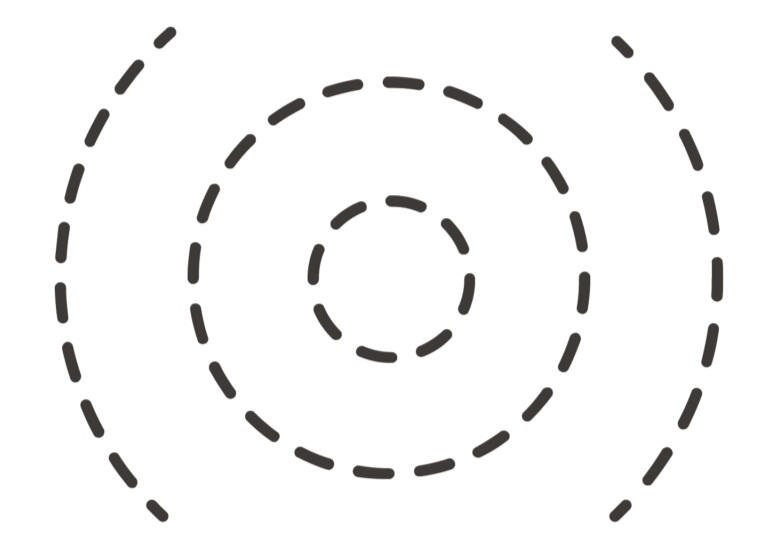
Graphical representation of the mapping of the different actors involved in the service, or the stakeholders. It allows the system to be read and its features to be understood, including its relations, in a way that involves the stakeholders through indicating their characteristics, position in the map and a representation of the different relations.
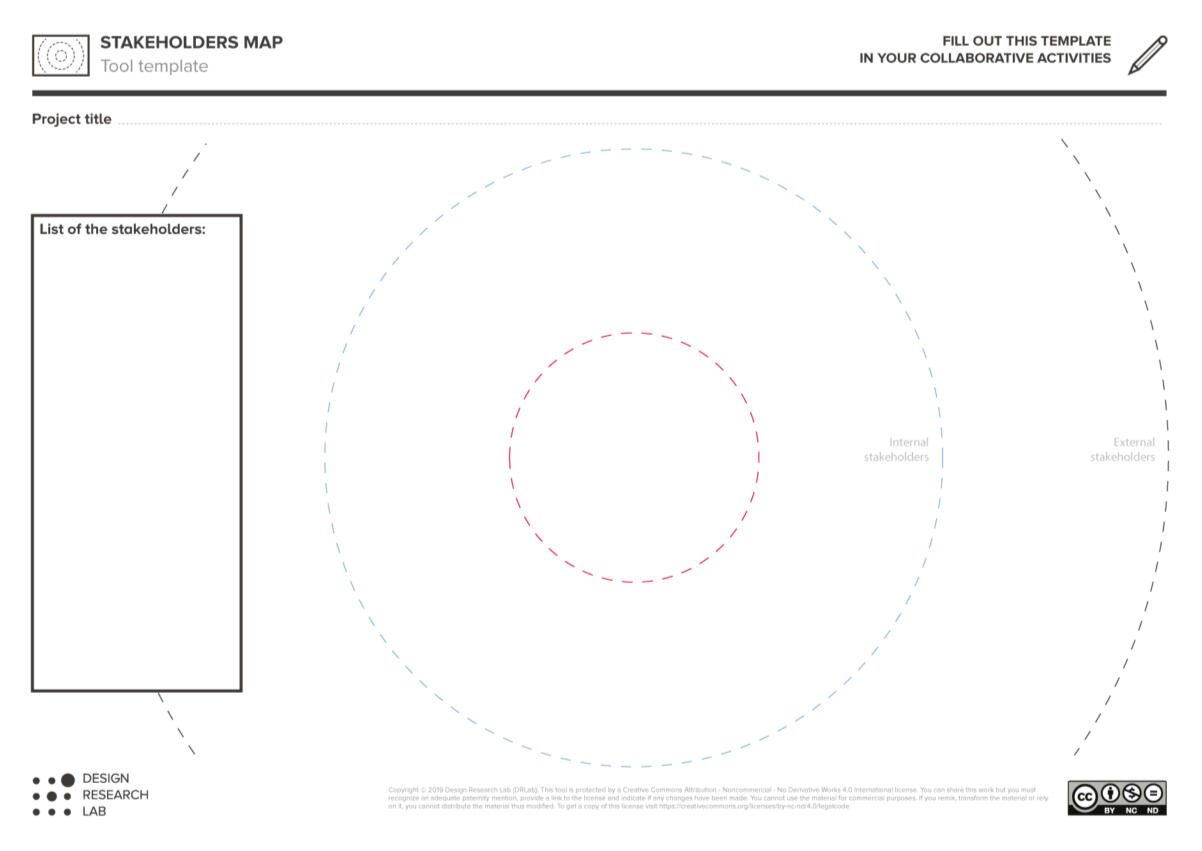
To download this image: (right) click on the image and select "save image as"
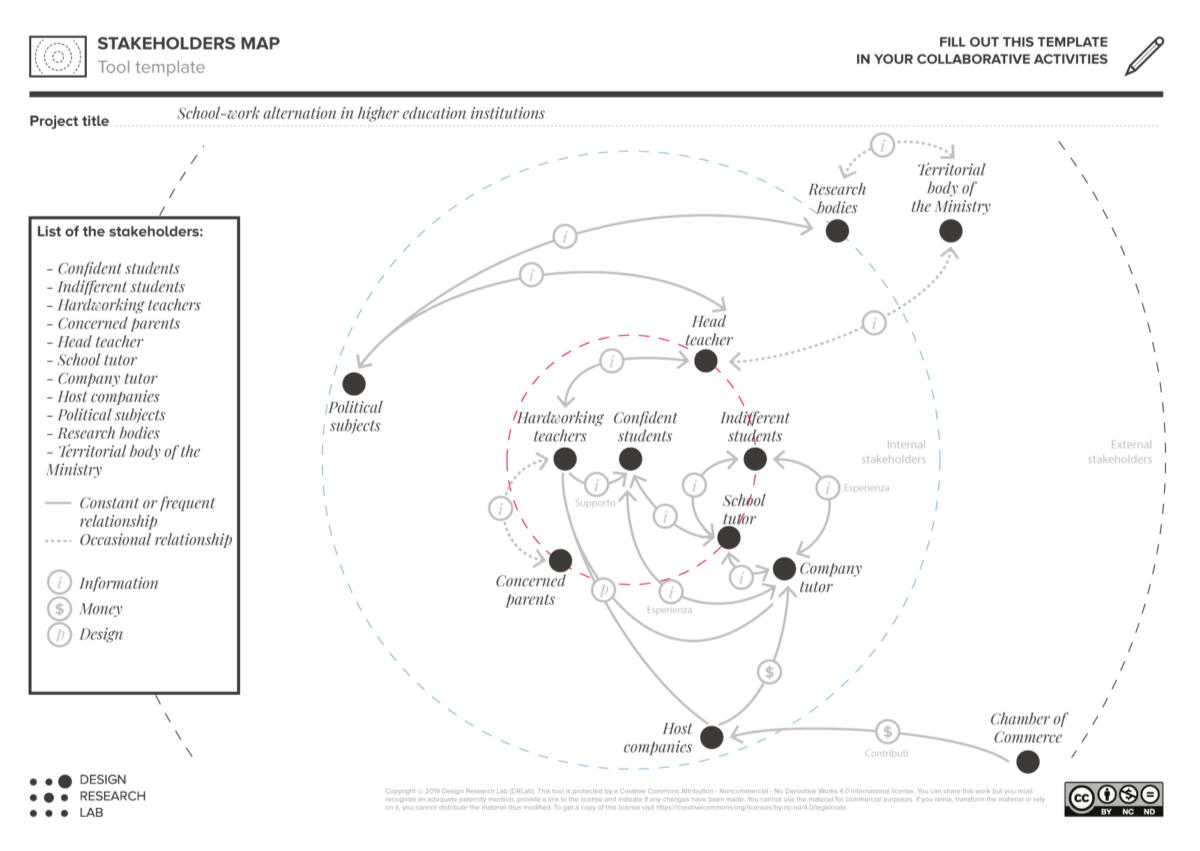
To download this image: (right) click on the image and select "save image as"
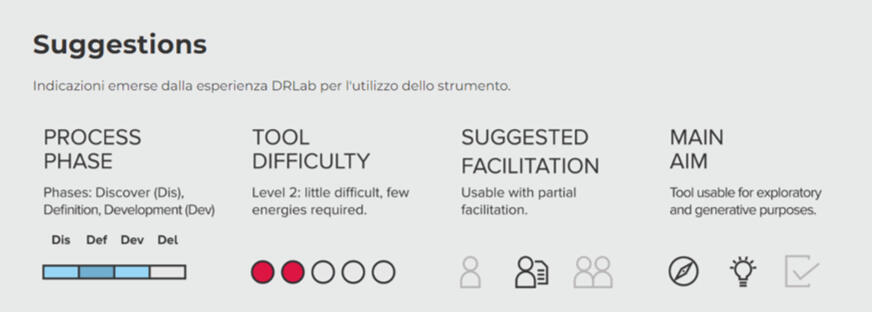
Instructions for using the template
Premise. This tool can be used to map an existing stakeholders system or to be identified according to the project.1. Indicate the project title.2. Identify all the stakeholders (people or groups) and list them with their respective roles and features.3. Starting from the centre of the map, position the stakeholders most involved in the service who can diversify according to the project goal.4. In the second band, place the important stakeholder groups, but those less involved in the service.5. In the third band, place the external stakeholder groups, i.e. those least interested in the service.6. Indicate for each sector the relations that run between the different groups. Show details and features of these relations, both formal and informal, which can show hierarchies and decision-making systems, as well as eventual bottle-necks and other structural forms.
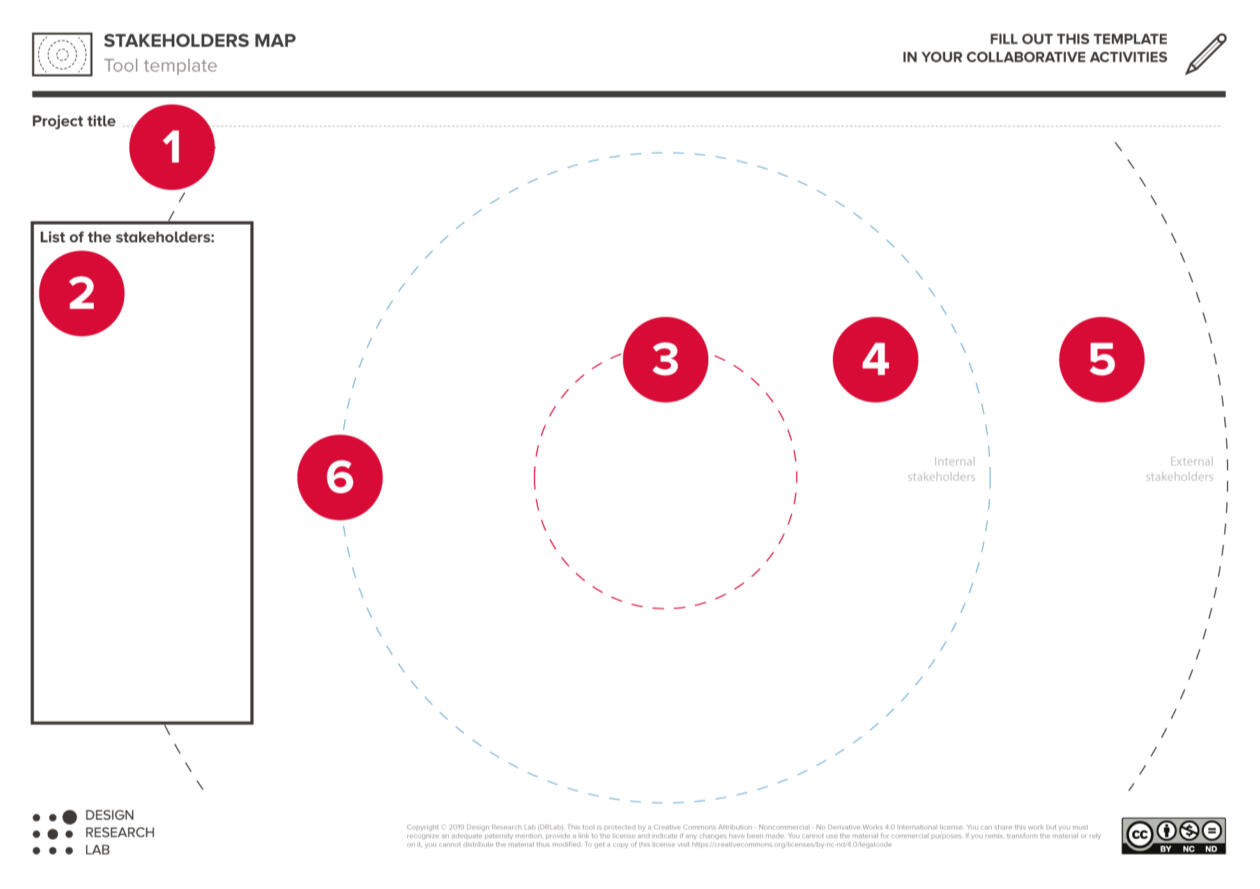
N.B. An effective map includes stakeholders that can be in contact with the system.Indicate their real roles, in line with project sustainability. Indicate stakeholders too broadly can decrease the tool’s efficacy. E.g. a very large organization can be indicated through its department, branch or office which is more easily in contact with the dynamics of the project.
References
Clarkson, P.J., Coleman, R., Hosking, I., & Waller, S.D. (2011). InclusiveDesign Toolkit, Second Edition. Engineering Design Centre, University of Cambridge. Retrieved from www.inclusivedesigntoolkit.comHanington, B.; Martin, B. (Eds.) (2012). Universal Methods of Design: 100 Ways to Research Complex Problems, Develop Innovative Ideas, and Design Effective Solutions. Rockport PublishersMorelli, N., & Tollestrup, C. (2007). New Representation Techniques for Designing in a Systemic Perspective. In Design Inquiries, Nordes 07 ConferenceStickdorn, M., Lawrence, A., Hormess, M., & Schneider, J. (2018). This is service design doing: Applying service design thinking in the real world. O’Reilly Media, Inc.
Problem Tree
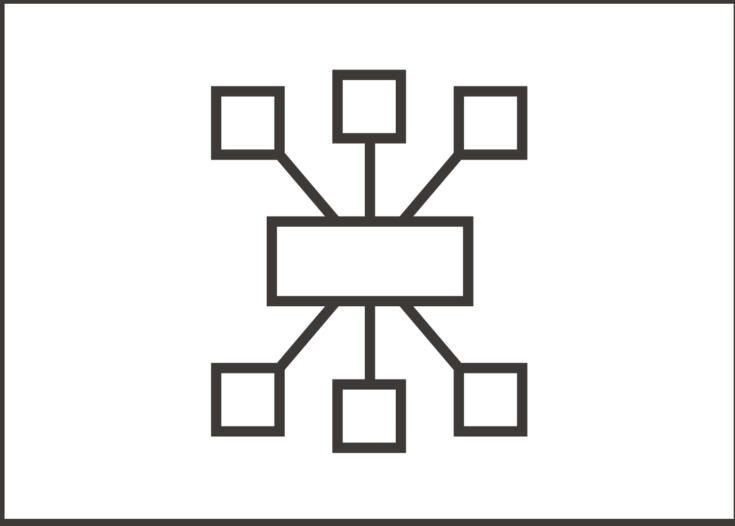
Diagram that maps problems and locates issues according to relations of cause and effect, activating discussion and identifying the issues which require strategic intervention.
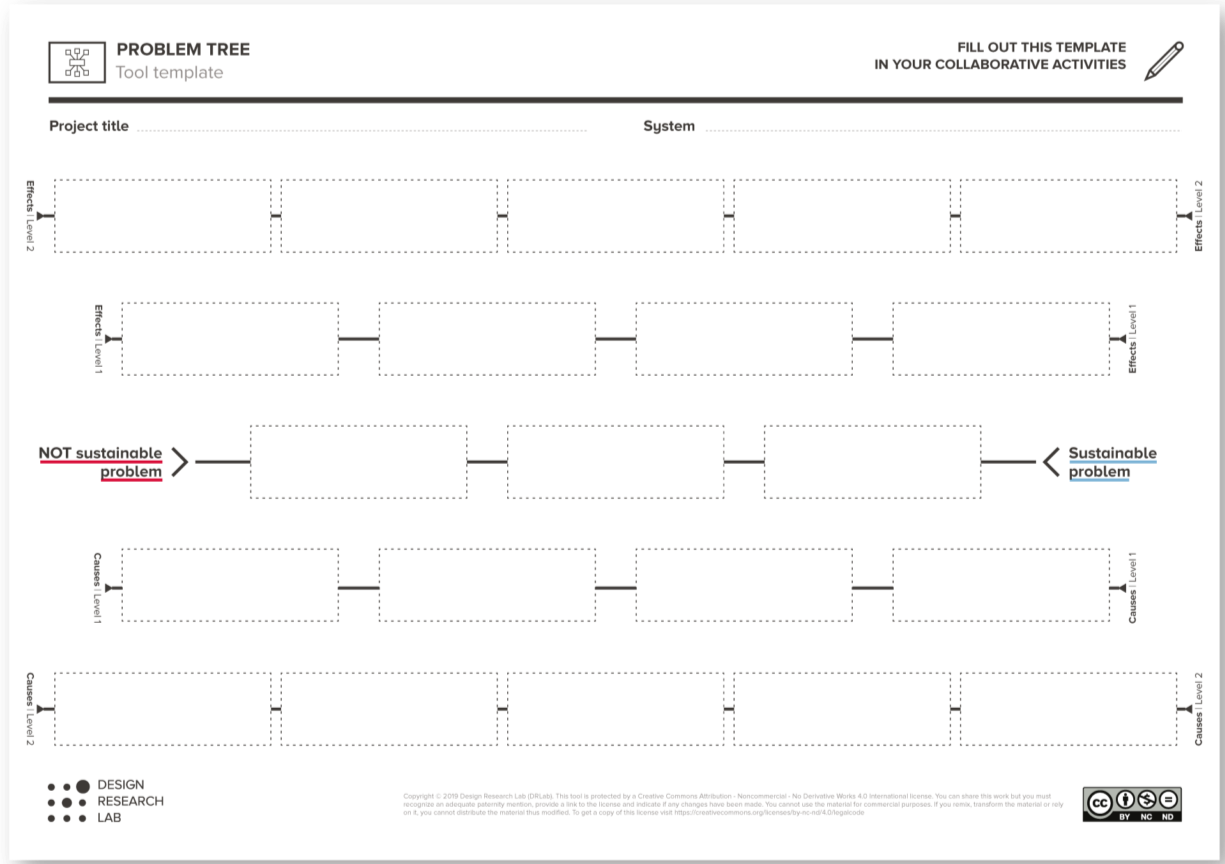
To download this image: (right) click on the image and select "save image as"
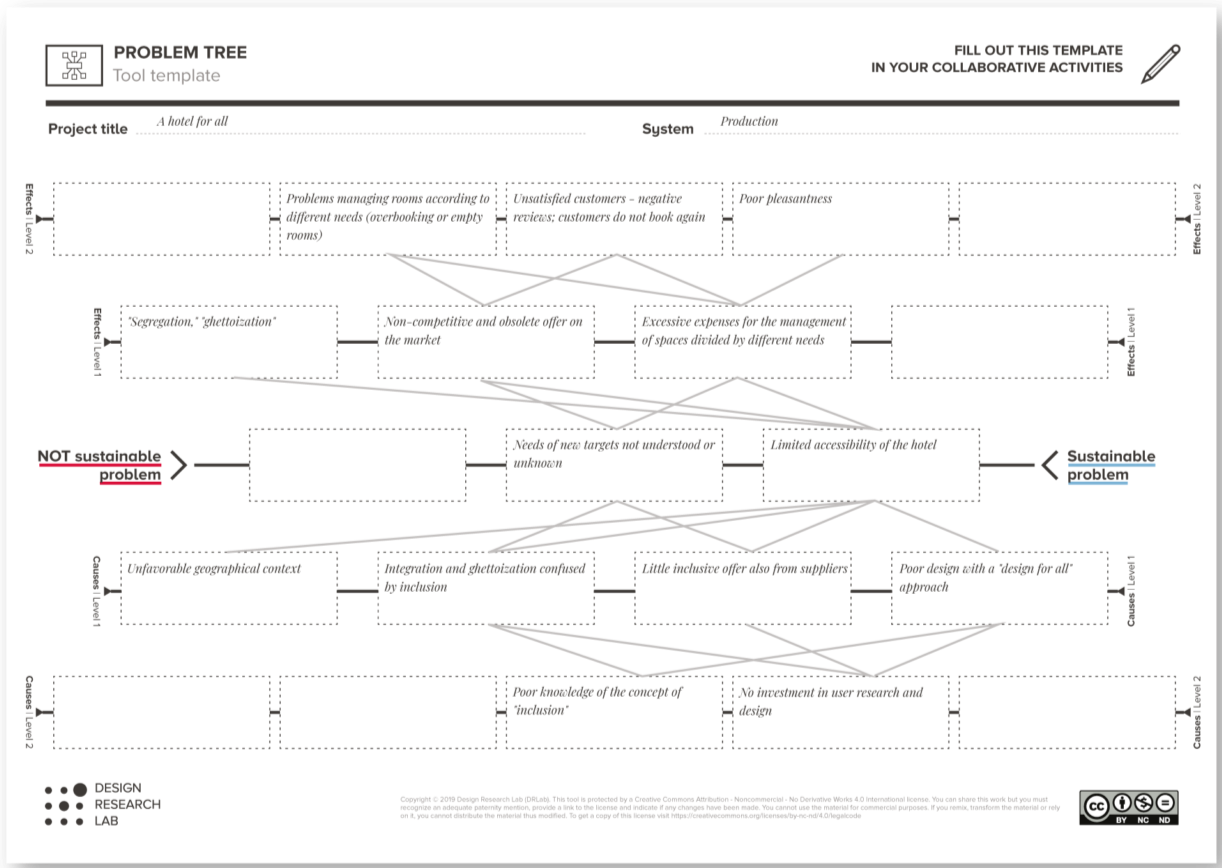
To download this image: (right) click on the image and select "save image as"
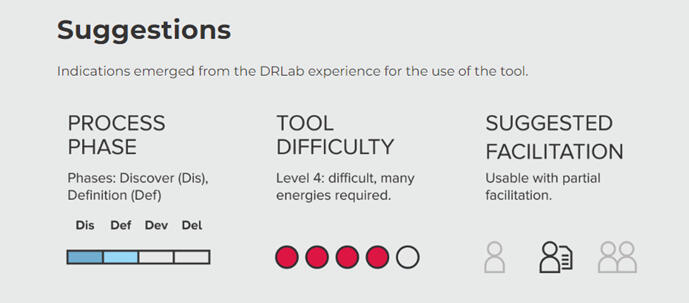
Instructions for using the template
1. Write the project title and the reference systems that is analysed with the tool.2. List the main problems identified in the reference system, noting their definition in the central row. Note the least sustainable problems on the left, along with the apparently unmanageable problems and those dependent on an external force; on the right put those problems perceived as more sustainable.3. Starting from the central row, note below the causes of the main problems already identified, putting them on two levels according to the dynamics of cause and effect. A note of warning: it’s useful to use post-its at this point so you can move the problems around adapting them to the dynamics of cause and effect in accordance with the development of your reflections.4. Beginning with the central row, note above the effects and consequences of the main problems already identified, organizing them on two levels according to the dynamics of cause and effect. Again, it’s advisable to use post-its to adapts the words to the dynamics.
N.B. An effective map includes stakeholders that can be in contact with the system.Indicate their real roles, in line with project sustainability. Indicate stakeholders too broadly can decrease the tool’s efficacy. E.g. a very large organization can be indicated through its department, branch or office which is more easily in contact with the dynamics of the project.
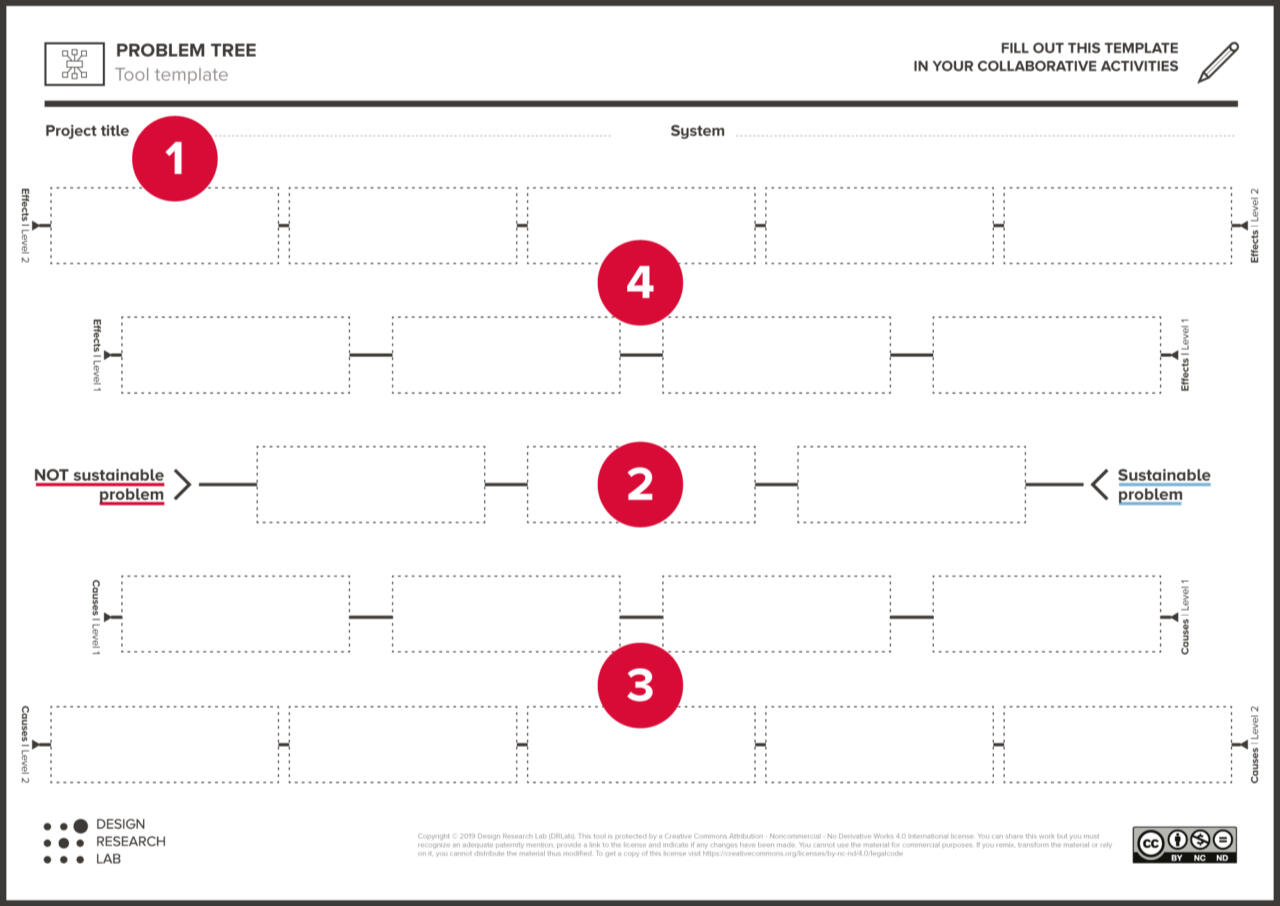
To download this image: (right) click on the image and select "save image as"
References
European Commission (2004). Project Cycle Management Guidelines: Volume 1. Brussels: EuropeAid Cooperation Office. Retrieved from European Union website https://europa.eu/capacity4dev/dear-programme/documents/europeaid-project-cycle-management-guidelinesFood and Agriculture Organization of the United Nations (n.d.). Capacity-focused Problem Tree. Retrieved from http://www.fao.org/capacity-development/resources/practical-tools/capacity-assessment/problem-tree-tool/en/United States Agency for International Development (USAID) (2012). The Logical Framework. Technical Note, Number 2, Version 1.0. USAID.
Personas
Representative profile of a particular group of people, such as a market segment, a group of users, or any group of stakeholders. The profile is not a stereotype but an archetype based on real research; even if the figure itself is fictional, this helps to identify groups with similar needs and behaviour.
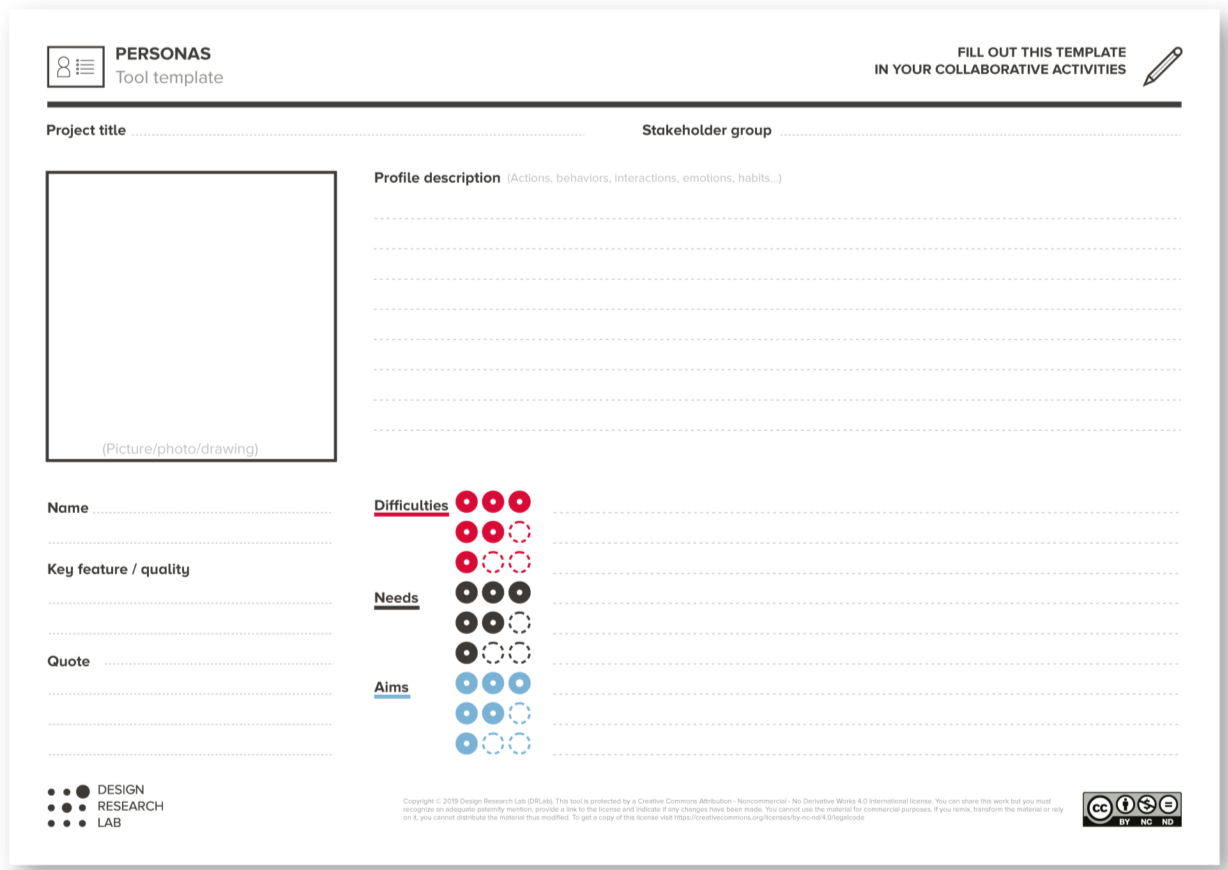
To download this image: (right) click on the image and select "save image as"
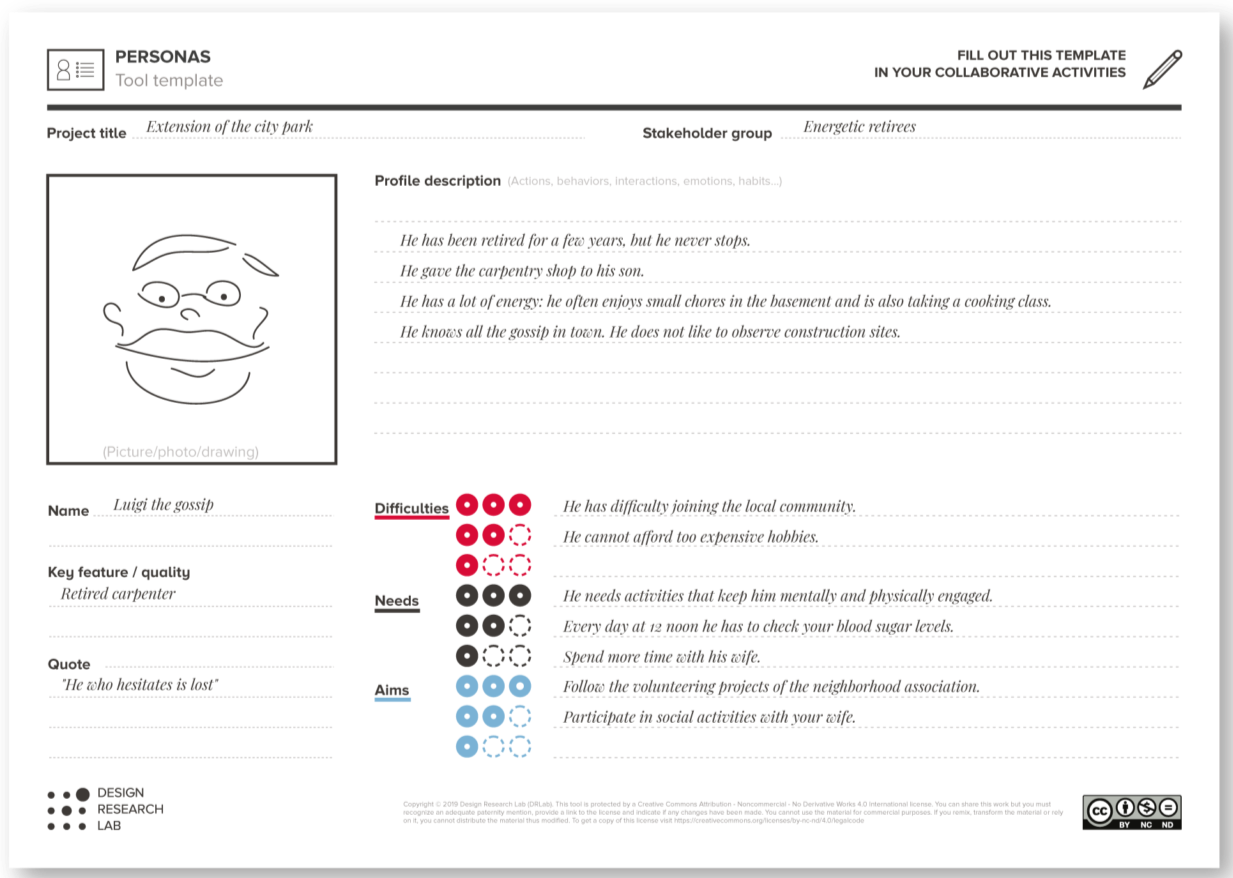
To download this image: (right) click on the image and select "save image as"
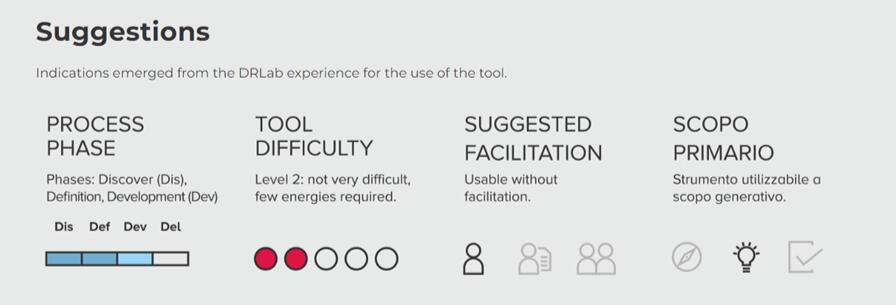
Instructions for using the template
1. Indicate the project title. Indicate the stakeholder group to which the profile belongs.2. Make a drawing or insert a photograph that represents the profile, avoiding the use of images that refer to prejudices of gender, ethnicity or stereotypes.3. Assign a name to the profile that reflects the following features:- it immediately suggests a cultural and social context of reference- it indicates a feature or key quality of the profile and immediately connects to astakeholder group4. Write a motto or a quotation that helps sum up the attitude of the profile in a single sentence.5. Describe the profile through features that can show personality, habit, interest, particular skills, needs, expectations, motivations, frustrations or backgrounds of the persona. Include details important for context and goals.6. Describe problems and difficulties, desires or ambitions of the profile in relation to context and goals. Assign each of the indications a relative value according to its importance or impact.
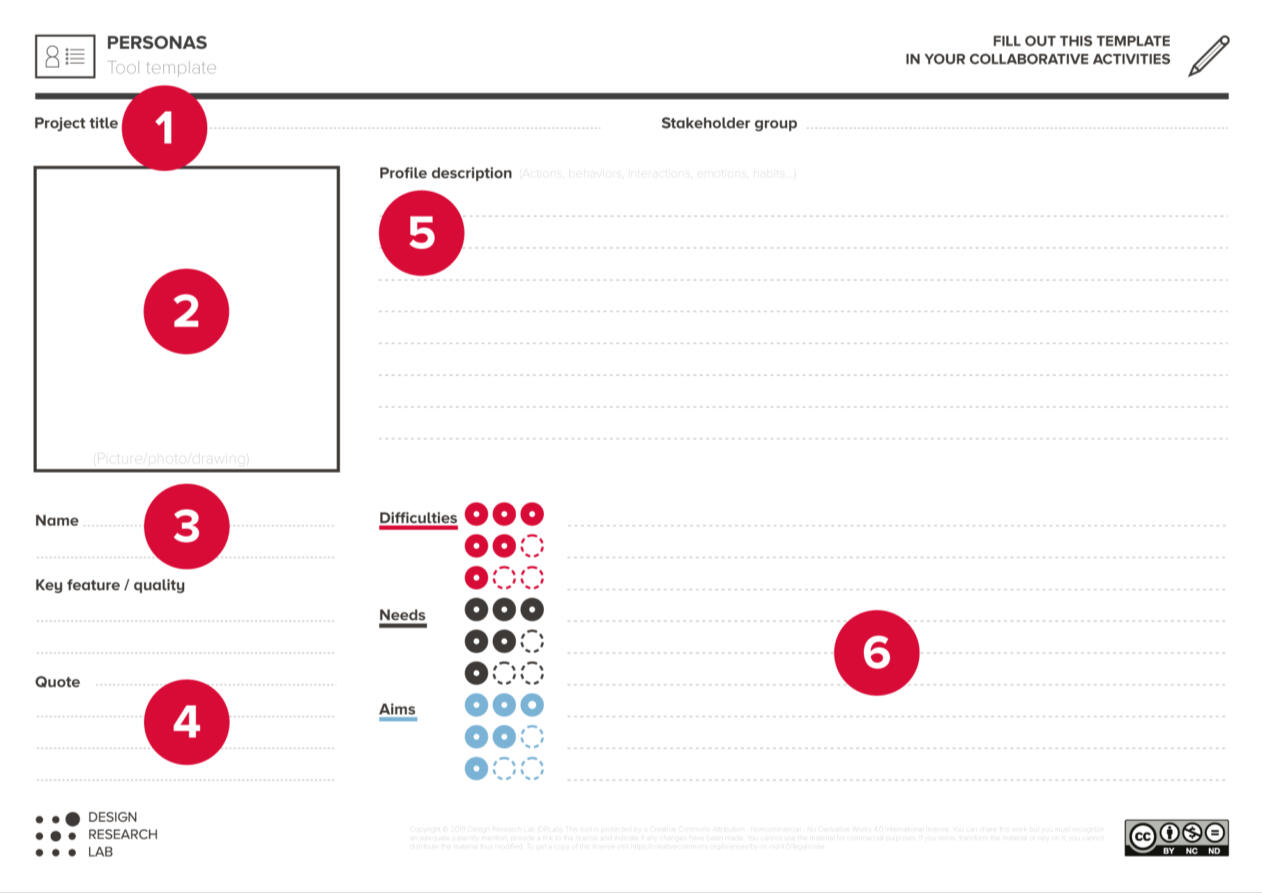
To download this image: (right) click on the image and select "save image as"
N.B. Be careful not to fall into stereotypes.N.B. The number of personas profiles should be proportionate to the type of project and therefore to the type and quantity of data available from previous research phases. Specifically, the number of profiles generated depends on the heterogeneity of the characteristics of the users on which a specific project is focused. In general, and also based on the number of people in the project team, with more than six personas profiles, it is difficult to distinguish and memorize the different characteristics of the individual profiles effectively.
References
Cabinet Office (2016). Open Policy Making toolkit. UK Government. Retrieved from https://www.gov.uk/guidance/open-policy-making-toolkitClarkson, P.J., Coleman, R., Hosking, I., & Waller, S.D. (2011). Inclusive
Design Toolkit, Second Edition. Engineering Design Centre, University of Cambridge. Retrieved from www.inclusivedesigntoolkit.comHanington, B., & Martin, B. (2012). Universal methods of design: 100 ways to research complex problems, develop innovative ideas, and design effective solutions. Rockport Publishers.Kumar, V. (2013). 101 Design Methods: A Structured Approach for Driving Innovation in Your Organization. John Wiley & Sons.Stickdorn, M., Lawrence, A., Hormess, M., & Schneider, J. (2018). This is service design doing: Applying service design thinking in the real world. O’Reilly Media, Inc.
Guidelines
Discover expertly curated articles, website links and books to elevate your knowledge. Explore our comprehensive collection of guidelines for insights and growth.
| Guideline | Description | Author | Source | Link |
|---|---|---|---|---|
| The communication of service design | Dissertation about how to communicate service design effectively. Including a "how-to" roadmap. | Danielle Zsifkovits | Lauda | PDF Link |
| The difference between a journey map and a service blueprint | Guide to practical blueprinting of services | Morgan Miller & Erika Flowers | Medium | Link |
| Tools for Systems Thinkers: Systems Mapping | Guide to practical system thinking | Leyla Acaroglu | Medium | Link |
| More coming soon... |
Articles
Free and open-source library of articles, topics and trends practical on service design from around the web.
| Article | Description | Author | Source | Link |
|---|---|---|---|---|
| Stop doing digital transformation | Service design as a tool for digitalization and organisational change | Jessica Sherratt | Medium | Link |
| Why we changed the format of the service blueprint | Megan is proposing a new outline and execution of service blueprinting (2/2) | Morgan Miller | Medium | Link |
| More coming soon... |
Privacy Police
1. Introduction and general information
Thank you for your interest in our website. The protection of your personal data is important to us. In the following, you will find information on how we handle your data that is collected through your use of our website. Your data will be processed in accordance with the legal regulations on data protection.Notice: The word DSGVO means in English GDPR.1. Person responsible in the sense of the DSGVO / GDPRAhmed Abdelmoula
Via dei Solteri, 105, 3812
Trentino Alto Adige, TN, ItalyName: Ahmed Abdelmoula
Mail: [email protected]2. Definitions
Our privacy policy should be simple and understandable for any person. In this privacy policy, the official terms of the General Data Protection Regulation (DSGVO/GDPR) are generally used. The official definitions are explained in Art. 4 DSGVO/GDPR.
2. Server log files
When you access our website, it is technically necessary for data to be transmitted to our web server via your Internet browser. The following data is recorded during an ongoing connection for communication between your Internet browser and our web server:
Date and time of the request
Name of the requested file
Page from which the file was requested
Access status
Web browser and operating system used
(Complete) IP address of the requesting computer
Amount of data transferred
We collect the listed data to ensure a smooth connection setup of the website and to enable a comfortable use of our website by the users. In addition, the log file is used to evaluate system security and stability as well as for administrative purposes. The legal basis for the temporary storage of the data or the log files is Art. 6 para. 1 lit. f DSGVO.
3. Cookies
The cookie settings can be managed under the following links for the respective browsers:
You can also individually manage the cookies of many companies and functions that are used for advertising. To do this, use the corresponding user tools, available at https://www.aboutads.info/choices/ or http://www.youronlinechoices.com/uk/your-ad-choices.Most browsers also offer a so-called "do-not-track" function, which you can use to indicate that you do not wish to be "tracked" by websites. When this feature is enabled, the browser tells ad networks, websites, and applications that you do not want to be tracked for behavioral advertising and the like.Additionally, you can prevent the loading of so-called scripts by default. NoScript allows JavaScripts, Java, and other plug-ins to run only on trusted domains of your choice. Information and instructions on how to edit this feature are available from your browser vendor (e.g. for Mozilla Firefox at: https://addons.mozilla.org/de/firefox/addon/noscript/). Please note that if you disable cookies, the functionality of this website may be limited.
4. Third-party tools
Google AnalyticsWe also utilize Google Analytics, a web analytics service provided by Google. Google Analytics uses cookies and similar technologies to analyze website traffic and user behavior information in an anonymous form. The data generated by these cookies about your use of the website, including your IP address, may be transmitted to and stored by Google on servers in various locations globally.Google Analytics helps us understand how users interact with our website, track website activity, and generate reports to improve our website's performance and user experience. This data is used for statistical purposes only and does not include personally identifiable information. We have enabled IP anonymization within Google Analytics, which masks the last portion of your IP address to ensure your privacy.You can prevent the collection and processing of data generated by Google Analytics by installing the Google Analytics Opt-out Browser Add-on. This add-on instructs the Google Analytics JavaScript (ga.js, analytics.js, and dc.js) running on websites to prohibit sending information to Google Analytics. You can find more information about Google Analytics and its privacy practices by visiting the Google Analytics Terms of Service and Google Privacy Policy.Please note that third-party tools, such as Wix and Google Analytics, may have their own privacy policies regarding the collection, storage, and use of your data. We recommend reviewing their respective privacy policies to understand how your information is handled when using their services.
5. Data sharing and recipients
A transfer of your personal data to third parties does not take place unless:if we have explicitly pointed this out in the description of the respective data processing.if you have given your express consent in accordance with Art. 6 para. 1 p. 1 lit. a DSGVO,the disclosure according to Art. 6 para. 1 p. 1 lit. f DSGVO is necessary for the assertion, exercise or defense of legal claims and there is no reason to assume that you have an overriding interest worthy of protection in the non-disclosure of your data,in the event that a legal obligation exists for the disclosure pursuant to Art. 6 (1) sentence 1 lit. c DSGVO, andas far as this is necessary for the processing of contractual relationships with you according to Art. 6 para. 1 p. 1 lit. b DSGVO.
6. Data security
We take appropriate technical and organizational measures in accordance with Article 32 of the GDPR, taking into account the state of the art, the costs of implementation and the nature, scope, circumstances and purposes of the processing, as well as the varying likelihood and severity of the risk to the rights and freedoms of natural persons, in order to ensure a level of protection appropriate to the risk. This website uses SSL encryption for security reasons and to protect the transmission of confidential content.
7. Duration of the storage of personal data
The duration of the storage of personal data is measured by the relevant statutory retention periods (e.g. from commercial law and tax law). After expiry of the respective period, the corresponding data is routinely deleted. If data is required for the fulfillment or initiation of a contract or if we have a legitimate interest in continuing to store it, the data will be deleted when it is no longer required for these purposes or you have exercised your right of revocation or objection.
8. Your rights
In the following, you will find information on which data subject rights the applicable data protection law grants you vis-à-vis the controller with regard to the processing of your personal data:
Right to information pursuant to Art. 15 DSGVO
The right to request information about your personal data processed by us in accordance with Art. 15 DSGVO. In particular, you can request information about the processing purposes, the category of personal data, the categories of recipients to whom your data has been or will be disclosed, the planned storage period, the existence of a right to rectification, erasure, restriction of processing or objection, the existence of a right of complaint, the origin of your data if it has not been collected by us, as well as the existence of automated decision-making, including profiling, and, if applicable, meaningful information about its details.
Right to rectification pursuant to Art. 16 DSGVO.
The right to demand the correction of inaccurate or incomplete personal data stored by us without undue delay in accordance with Art. 16 DSGVO.
Right to deletion pursuant to Art. 17 DSGVO.
The right to request erasure of your personal data stored by us pursuant to Art. 17 DSGVO, unless the processing is necessary for the exercise of the right to freedom of expression and information, for compliance with a legal obligation, for reasons of public interest, or for the establishment, exercise or defense of legal claims.
Right to restrict processing pursuant to Art. 18 DSGVO.
The right to request the restriction of the processing of your personal data in accordance with Art. 18 DSGVO, insofar as the accuracy of the data is disputed by you, the processing is unlawful, but you object to its erasure and we no longer need the data, but you need it for the assertion, exercise or defense of legal claims or you have objected to the processing in accordance with Art. 21 DSGVO.
Right to information pursuant to Art. 19 DSGVO.
If you have asserted the right to rectification, erasure or restriction of processing against us, we are obliged to inform all recipients of your personal data of this in accordance with Article 19 DSGVO, unless the notification is impossible or involves disproportionate effort. You have the right against the controller to be informed about these recipients.
Right to data portability pursuant to Art. 20 DSGVO.
The right, pursuant to Art. 20 DSGVO, to receive your personal data that you have provided to us in a structured, commonly used and machine-readable format or to request that it be transferred to another controller.
Right to lodge a complaint pursuant to Art. 77 DSGVO.
The right to complain to a supervisory authority in accordance with Art. 77 DSGVO. As a rule, you can contact the supervisory authority of the federal state of our registered office stated above or, if applicable, that of your usual place of residence or workplace for this purpose.
Right to revoke consent given in accordance with Art. 7 (3) DSGVO.
You have the right to revoke consent to the processing of data, once granted, at any time with effect for the future. In the event of revocation, we will immediately delete the data concerned, unless further processing can be based on a legal basis for processing without consent. The revocation of consent shall not affect the lawfulness of the processing carried out on the basis of the consent until the revocation.
9. Right of objection
Insofar as your personal data is processed by us on the basis of legitimate interests pursuant to Art. 6 (1) p. 1 lit. f DSGVO, you have the right to object to the processing of your personal data pursuant to Art. 21 DSGVO, insofar as this is done for reasons arising from your particular situation. Insofar as the objection is directed against the processing of personal data for the purpose of direct marketing, you have a general right of objection without the requirement to specify a particular situation.If you wish to exercise your right of revocation or objection, simply send an e-mail to [email protected].
10. External links
Social networks (Facebook, Twitter, Xing, YouTube and Google +) are integrated on our website as links to the corresponding services. After clicking on the embedded text/image link, you will be redirected to the page of the respective provider. Only after the redirection is user information transmitted to the respective provider. From here on, the privacy policy of the respective pages in social media applies. For information on the handling of your personal data when using these websites, please refer to the respective privacy policy of the providers you use.
11. Subject to change
We reserve the right to adapt or update this data protection declaration if necessary in compliance with the applicable data protection regulations. In this way, we can adapt it to the current legal requirements and take into account changes to our services, e.g. when introducing new services. The most current version applies to your visit to the website.
Status of this data protection declaration: August 25 2025© 2025 servicedesign.today All rights reserved.
